Blog Posts


Leadership Lessons from COVID-19: Building Future Ready Leaders
This article was originally published by the Indian School of Business here.
“In a volatile and dynamic world, be ready for change. Always look at it as an opportunity to learn rather than resisting it due to fear of failure.” - Jerry Connor, Global Practice Head, BTS.
COVID-19 has turned the world upside down and how! Globally, a majority of the workforce is working from home and that is the ‘new normal.’ According to a study [1] at the Stanford Institute for Economic Policy Research (SIEPR), in the United States alone, 42 percent workers are now working from home full time, accounting for more than two-thirds of economic activity.

Nearly four-in-ten people in the EU began working from home as a result of the COVID-19 pandemic, a new Eurofound Survey [2] has found.Economies are rapidly changing. Markets are shifting by the hour. Majority of business houses are going through a massive downturn. At the same time, many business houses are making efforts to salvage the situation and are being diligent in rapid resource allocation. Consequently, business leaders and executives have been pushed into a dark arena they know little about. As leaders, however, they are expected to move ahead with the times and deal with the uncertainty to evaluate the situation, evolve with it and take decisions, putting aside their own fears.It is during these critical circumstances that they are required to come up with novel strategies. Business leaders and management practitioners can take this pandemic as an opportunity to develop new managerial skills and establish effective management practices for their peers to emulate or not do anything and await the waves that will be coming to pass.One of the greatest challenges facing leaders is that most of them may have a limited understanding of how to deal with such a dire global economic crisis and have naturally been caught unawares. Leaders who can reorient themselves and their activities manage to deal with the hard times and navigate their companies through the disruption. In contrast, leaders who do not reinvent some of their time-tested leadership skills tend to become anxious and stay away from taking action and barely survive the crunch.So how should leaders prepare themselves to face a crisis, manage through it and come out of it successfully? To find out, we spent the last couple of months talking to top Human Resource (HR) leaders in 40 of the world’s best companies. Primarily in Chief Talent Officer (CTO) or Chief Learning Officer (CLO) roles, these individuals provided fascinating insights into what organisations themselves are identifying as critical capabilities in dealing with the COVID crisis.Based on our work with leaders across organisations over the years, some key attributes and skills that future leaders need to develop in themselves to sustain through any crisis include accepting change as is, being empathetic and thoughtful leaders and being able to foster a growth-oriented mindset besides developing mature leadership skills.The McKinsey Global Institute workforce surveyed [3] 3,031 business leaders in Canada, France, Germany, Italy, Spain, the United Kingdom and the United States to understand the skills that would be most in-demand by 2030. They found that the demand for higher cognitive, technological, social and emotional skills will grow, while the need for physical, manual and basic cognitive skills will decline.From our recent studies of organisations during the pandemic, here are four key skills that leaders need to acquire to emerge out of a crisis successfully:
1. Seizing Momentum
One of the most common characteristics of leaders who struggle during crisis is an over-reliance on processes. During such extraordinary circumstances, leaders need to step out of the processes-based rigmarole and seize the opportunity to lead their teams. Leaders who cannot work around weekly meetings, annual budgeting, decision making processes and so on will find it difficult to carry on. Leaders who thrive in an unpredictable environment focus less on process and more on outcomes. Exceptional leaders listen and sense the moments that have the biggest impact. People need direction and that is where the role of a leader becomes crucial in making the right decisions in times like these. The same is true of change. For several years we have been talking about and equipping leaders to ‘manage change’. It has become a staple of leadership development to learn the ‘change curve’ and think about the leaders’ role in helping people let go of the old and embrace the new. The old view of change encompassed a beginning, a middle and an end. The unstated assumption was that there was a ‘new normal’ after the change. However, leaders are increasingly experiencing a world in which change is constant. The most responsive leaders, therefore, expect this and rather than starting with a mindset of ‘how do we get through this change’, they start with an expectation that change is constant and with change comes opportunity.This means we need to accept that many of the models that we have relied on to understand change, such as the Kubler-Ross Change Curve [4] are not going to be of much help anymore.
2. Empathy
Empathy is one of the most significant skills that a leader should possess and is even more crucial in times of crisis. The outbreak of COVID-19 has set in motion a period of slow growth. Layoffs, delayed projects and cost cuts have become a global pattern. With remote working, the workforce is juggling multiple roles- that of parents to young children, caregivers to elderly at home and of community members supporting each other in rough times. The level of exhaustion is naturally much more as workers are constantly getting on and off virtual meetings. The fatigue of home and work melding together is slowly taking a toll. A survey [5] by Blind, an anonymous professional network with users from companies like Amazon, Facebook, Google and Bloomberg collected data from 12,737 responders about fears of being laid off, and beliefs about how long it will take for things to return to normal. 57% feared being laid off while 40.6% believed it will take six months to one year for life to go back to normal. Pre COVID, a similar survey [6] by Blind conducted in 2019 had 35.9 % responders expressing fears of being laid off.Another study by Blind captured emotional well-being due to social distancing in terms of loneliness, anxiety and productivity levels from 10,107 responses. 52.9% answered affirmative to increased loneliness during work from home while 56.4% reported experiencing increased feelings of anxiety during work from home.Given this situation, only an empathetic leader will be able to handle team members with understanding and sensitivity. For working from home to be sustainable, leaders need to set the required boundaries such as communicating on a quick phone call instead of a videoconference, setting up office hours for specific groups, sharing tips on time management, and establishing that it is understandable if emails are not being answered after a certain hour.Over the years, working with leaders at the helm, we have found that being an empathetic leader also gives one a chance to have a bigger sense of purpose. Let your workers voice their apprehensions. Keep in touch with colleagues and co-workers, check in on them often. Ask them if they are feeling overwhelmed at the end of the day or if they have too much to deal with. Commemorate little achievements of the team members to engender camaraderie and foster teamwork, despite being only virtually connected. Even 15-minute teleconferencing breaks or virtual water-cooler chats allow for vital, healthy informal connections.Not being able to foster connections in a non-traditional office set up is a struggle for many leaders. During one of the interviews, we found, “It may entail having to give up control and authority over the workforce”.Technology plays a key role in our lives and so the human connection can still be encouraged over and above the usage of technology. It is not a hindrance in forging human bonds. Various social distancing norms in place have helped us realize that one does not always need to meet someone in person to communicate effectively. Active listening and open discussions that voice encouragement and reassurance can help build morale in the team.
3. Leadership maturity
To be a mature leader, one needs to build on an emotional development path from early on. Often, adults go through various maturity shifts - some in the way they see the world and can relate to others easily, while some still grapple with problems at hand not knowing which direction to head towards. Emotionally mature leaders embark upon a path of holistic development from early on. It is a path of simultaneous growth, where a leader continues to grow on their own, becomes a role model for others, and at the same time handles crises at work.Leaders need to have that growth mindset, which is essentially about a willingness to make mistakes and learn from them. A true leader is one who not only notices when someone makes a mistake but is also there for them, asking all the right questions and discussing viable options to rectify the error in an attempt to develop better decision processes. Being empathetic towards others is a sign of emotional and leadership maturity. Leaders need not shy away from asking for help. It should be normalised for leaders in big institutional setups to seek help from their peers or teammates instead of being looked down upon as a feeble leader. Asking for advice does not make you weak or undermine your leadership.Most leaders operate in a success-driven paradigm. They are constantly under pressure to lead from the front and stay on top of things. At times, a leader cannot do all this without facing exhaustion and saturation. So, stop trying to be a leader all the time. Be a follower and let others take the lead sometimes. Try not to micromanage everything and do not always assert your superiority. One can be a leader and yet be vulnerable. A leader is allowed to break the mould and seek answers. Create space for others to solve problems at hand.
4. Purposeful Strategy
The year 2020 is a curveball stronger than anyone could have imagined. Nevertheless, a leader needs to be a North Star - leading the way in spite of adversities and is able to move towards a larger social purpose even in turbulent times. Many of the business houses we studied as part of the interview series were proud of how they had responded to the recent crises, both in looking after their people and in supporting the communities they serve. For example, an African agri-business described how its belief that purpose needs to come before profit had helped them through the crisis. Their operations had to be kept running and they were reliant on local communities and the communities were reliant on them. So the business quickly pivoted from making alcohol out of sugar cane to making hand sanitiser. Not only was this a profitable innovation but it also was a way to contribute to the health of the community in challenging times.Effective leadership is being able to see connections and interdependencies. Being able to see the larger picture enables leaders to take sharp decisions with minimal repercussions.Post a crisis, leaders tend to look at it in two ways, either as a temporary disruption or a fundamental change to the way they thought and led. This frame of mind impacts the way leaders deal with the future. For example, leaders who struggled tended to think in terms of classic planning processes, taking current trends and projecting them forward to create a plan. But when the future has so many diverse and difficult possibilities, the accuracy of predictions is severely compromised. Consider this, the oil prices have fallen through the floor. As a CEO from a global energy company pointed out, “no-one in their wildest dreams could have predicted the drop off in demand for oil that we just experienced.”Successful leaders took a different approach. Instead of looking at current trends, they envisioned future scenarios and looked back. They looked for ‘weak’ signals in the market and imagined the different ways in which they would evolve. These leaders then adopted specific courses of action with these in mind, constantly adjusting their picture as new data emerged. For instance, retailers that used to do 25% online sales are now relying on e-commerce to drive their sales which account for almost 70 % of their total business.Mounting work pressure coupled with a complete change in the workplace scenario has brought back the missing purpose to leadership while also appealing to the humanitarian side of leaders.
Final thoughts
In a volatile and dynamic world where things may get disruptive, it is vital to be ready for change. Always look at change as an opportunity to learn rather than resisting it due to fear of failure. As you grapple with the uncertainty, do not get stuck in linear thinking which can be constrictive, instead explore multiple ways of approaching the same problem.[1] Bloom, N.,2020. How working from home works out. Stanford Institue for Economic Policy Research.Policy Brief. Retrieved from https://siepr.stanford.edu/research/publications/how-working-home-works-out[2]https://ec.europa.eu/jrc/en/news/coronavirus-pandemic-reveals-large-differences-prevalence-telework-across-eu[3] Bughin, J., Subramaniam, A. & others, 2018.Skill Shift: Automation and the future of the Workforce. Discussion Paper. McKinsey Global Institute. Retrieved from https://www.mckinsey.com/featured-insights/future-of-work/skill-shift-automation-and-the-future-of-the-workforce[4] The 'change curve,' derived from the work of Kubler-Ross, describes the internal emotional journey that individuals typically experience when dealing with change and transition. This journey consists of several stages that people go through: shock and denial, anger, bargaining, depression, and acceptance.[5] Robinson, B. 2020. What Studies Reveal About Social Distancing And Remote Working During Coronavirus. Forbes. Retrieved from https://www.forbes.com/sites/bryanrobinson/2020/04/04/what-7-studies-show-about-social-distancing-and-remote-working-during-covid-19/#141fe0e6757e[6]https://www.teamblind.com/blog/index.php/2019/02/11/worried-about-layoffs-tech-employees-weigh-in-about-layoff-anxiety/

Why mindsets matter: The secret to lasting behavior change in moments
How do mindsets impact your behavior in moments?
Your life is built by the moments that you experience daily. As you enter each moment, your brain triggers a mindset that offers a thought, belief, feeling, or attitude. This mindset influences how you will engage in the moment presented. In other words, your behavior is directly influenced by the mindset that you adopt in each moment.

Here’s an example. Imagine you are receiving unexpected critical feedback from a respected coworker after giving a presentation to a group of senior leaders. How you react to that feedback will be shaped by the mindset that you adopt in that moment. There are three mindsets that could be activated:
- I believe my presentation was perfectly acceptable and no further improvement is needed.
- I believe my presentation was poor and I hope no-one noticed.
- I believe my presentation was perfectly acceptable yet there is always room for improvement.
Now think about how you would behave during and after your feedback conversation while holding each respective mindset.
- Which mindset will lead you toward taking action on improving your ability to present?
- Which mindset will have a greater impact on your overall personal development?
- Which mindset will have a greater likelihood of driving results that advance your career in the long run?
The answer to these questions is obviously the third mindset. It is consistent with the “growth mindset,” in which you believe that mistakes are opportunities for growth. There are a number of universal mindsets that are powerful for everyone – a growth mindset is one of them.
But, each universal mindset also has its “shadow”or a negative mindset that is triggered in specific moments. In the example provided, it is the fear of not getting it right. This shadow gets triggered if the presentation was particularly important, if you were presenting to an audience you found tricky, or even if you are having a stressful day. To change how you show up in key moments, it’s critical to be self-aware and look out for when you exhibit both constructive mindsets and the shadows that prevent you from exhibiting them.
Humans are not just reactive in terms of the mindset that become active. Choosing the mindset that is activated in each moment is fully under your control. While emotions are powerful and can easily lead to embracing a less productive mindset, you have the executive functioning capability to override your initial primitive emotional reactions.
Everyone has experienced adopting less productive mindsets during stressful moments, but the choice is always under your control. It is just a matter of being able to manage which mindset is elicited even when negative emotions like anxiety or fear are running high.
How can you change your behavior in the moment?
Changing behavior is not easy. It takes a lot of work and people often fail. So much so that many believe humans are incapable of change. People often fail to change because too much focus is placed on behaviors rather than the main inhibitor of successful change - mindsets.
Here’s an example. Suppose you just took a course to develop your reflective listening skills. Reflective listening is a powerful tool that helps people combat their own unconscious biases to increase their awareness of what others are truly communicating.
Using this tool allows you to check your interpretation of what others are saying and give the person a chance to correct your understanding. When used appropriately, reflective listening helps build both trust and empathy by making a person truly feel heard.
After completing this skill-building course, you are empowered to use this new skill on the job to build better relations and work more effectively with your coworkers.
Two weeks after you completed the reflective listening course, a team member, Taj approaches you with some big personal news that will impact his ability to show up for work for an undetermined amount of time.
Taj is currently leading an important initiative that is very visible in the eyes of senior leaders. The news is stressful for you because losing Taj at this stage of the project will very disruptive and possibly derail the success of the project.
How do you react when Taj is sharing the news? The perfect opportunity has arisen to use your new reflective listening skills, but will you? How you react depends on your mindset. There are two competing mindsets that could be elicited in this moment:
- At Taj’s level, you expect him to be able to juggle the personal and professional. You expect him to find a way to deliver his commitments regardless of what is happening outside of work.
- Taj may well need support in this difficult time. It is important to me to find the best way to help him regardless of current work demands.
If you have the first mindset when you enter the conversation with Taj, there is a low likelihood that you are going to engage in reflective listening due to your belief that a person must honor their work commitments first and foremost. Embracing this belief will lead you to set the precedent that Taj must figure out some way to fulfill his obligation.
Your ability to truly show your new reflective listening skill is blocked when you have the first mindset. It’s not because you don’t have the skill to demonstrate reflective listening behaviors, it’s because your mindset leads you down a path that shows a different set of behaviors.
Conversely, entering into the conversation with the second mindset primes you to show empathy towards Taj, which is the basis of reflective listening. The congruity between your mindset and behavior in this instance set you up to use your new skill without experiencing any internal discord.
This lack of dissonance between the mindset and behavior is important. When you enter a situation with a mindset to “experience and understand Taj’s world,” listening is natural. But sometimes these moments are triggers. For example, you may feel differently if Taj has a history of taking time off for personal reasons or you feel personal pressure to succeed on the project. In these situations, you are unlikely to have the mindset, “experience and understand others’ worlds” and may enter the situation expecting Taj to deliver, as in the first mindset.
What is holding people back from changing their behavior in moments?
True behavior change will not happen without making the proper mindset shifts. People often assume that skill development equals behavior change, meaning a person will demonstrate new behaviors if they develop a new skill. Unfortunately, it isn’t that simple. Just because a person develops a new skill doesn’t mean they will demonstrate it if there isn’t harmony between their new behaviors and mindset in each situation they experience.
Yet it does take more than one instance of showing new behaviors in order to signify true change. Demonstrating the set of new behaviors in a single instance is not a case for change. It takes repetition for a person to build new habits to allow them to move away from instinctively using old behavioral patterns in similar moments.
Most individual development plans or programs being delivered in organizations today are primarily centered around skill-building. While the focus around skill development does teach people how to perform new behaviors, it doesn’t target the mindset shifts necessary to actually leverage those skills when the relevant moment appears.
Without a shift in mindset, you will continue to perform the behaviors aligned with your current mindset and never use your new skill even if you know how to perform it. A mindset shift needs to happen first to enable you to show your new set of behaviors.

Emerging from the crisis: Findings from global financial services research
The events of 2020 marked a year of unparalleled uncertainty and speed of change. These challenges pushed leaders and organizations to react in extraordinary ways - undergoing strategic transformation in months rather than years. Financial services organizations were uniquely impacted, serving as a central shock absorber for countries and economies impacted by the crisis. As a result, financial services organizations are experiencing significant change and will continue to do so over the coming years.Based on research from interviews with 45 executives across 21 financial services organizations in 15 countries, this report outlines the 5 ways in which financial services organizations have changed and will continue to do so in the future.

10 rules to ace the interview—as the interviewer
Job interviews aren’t just high-stakes for candidates, they’re high-stakes for organizations as well: research indicates that a bad hire can cost an organization twice their annual salary or more.
Because interviews often play a critical role in the final hiring decision, it’s important to follow a few simple, easy-to-implement rules that will ensure your interviewing process is highly effective, unbiased, and legally defensible—before, during, and after the actual conversation with a candidate. At a time when interviews are primarily conducted via video or telephone rather than in-person, the time is right for organizations to review their interviewing practices and procedures to maximize their utility. Even if interviews are not always conducted in person, the fundamental approach—and, therefore, best practices—remain the same.

Before the interview
A successful interview process begins long before the candidate and interviewer meet. Executing effective and legally defensible interviews requires a high level of preparation for organizations and interviewers.
- Establish essential skills and behaviors for successful job performance. Focus on the role’s key responsibilities, and then determine the knowledge, skills, competencies, and behaviors required to perform those activities effectively.
- Build a structured interview guide with questions focused on these essential skills and behaviors. It’s important that every candidate is asked a standardized set of questions to ensure the interviewer covers all necessary topics and obtains consistent information from which to base their hiring decision.
- Create evaluation standards or guidelines. These direct the interviewer’s attention to the relevant information in candidates’ responses. (More on this later!)
- Train your interviewers. The person conducting the interview should be properly trained in effective interviewing techniques—not only to select the most qualified candidate, but to do so in a fair, unbiased, and legally defensible manner.
During the interview
Keeping preparation top of mind during the interview will help interviewers ensure that they remain aligned with the organization’s evaluation objectives. Interviewers should capitalize on the below methods to maximize the yield from their time and efforts.
- Follow the interview guide closely. The above preparation helps facilitate a useful conversation during the interview, but the interviewer must follow the interview guide closely to ensure all candidates respond to the same information. Allowing the candidate to steer the conversation can derail the quality of the information collected and potentially allow the candidate to misrepresent their capabilities, a costly mistake for the organization down the road.
- Ask behaviorally-based past approach questions. The best predictor of future behavior is past behavior, so very specific questions such as, “Please describe a time when you had to work closely with someone you did not particularly like to accomplish an important objective,” yield the most accurate representation of a candidate’s tendencies and performance. For less experienced candidates, reframing the question as a hypothetical situation may be more appropriate and easier for the candidate to answer. For example, rephrasing the question as “Imagine that you have to work closely with someone you do not particularly like to accomplish an important objective. How would you handle this situation?” (not “how should you handle this situation?”).
- Ask probing questions. Open-ended questions elicit the most possible information from the candidate, so interviewers should always start with these. Then, they’ll likely need to dig deeper to obtain enough information to make a more informed evaluation. Probing follow-up questions help interviewers gather more detail about the context, the people involved, the candidate’s actions and reasoning, and the outcomes.
- Consider using a role play. Don’t just take the candidate’s word for it—use a behavioral role-play to give candidates the opportunity to demonstrate their capabilities. Role plays engage candidates in business challenges (e.g., customer interaction) like those faced on the job. Not only do role-plays give organizations more confidence in their hiring choices, but they also enhance the candidate experience—candidates perceive the assessment as fair, whether they’re offered the job or not.
After the interview
You’ve prepared extensively. You’ve conducted the interviews. Now what?
- Use the pre-established rating scale to score the candidate’s response. Remember those evaluation rules from “before the interview”? This is where they come into play. A clear rating system is essential to a fair assessment of each candidate. This evaluation becomes relatively straightforward with a pre-established evaluation scale. The most effective evaluation scales clearly define what constitutes a good response using behavioral examples, leaving less room for bias and error when assigning ratings to candidates. One type of rating scale, behaviorally anchored rating scales (BARS), gives examples of behaviors paired with corresponding numbers to indicate high, moderate, or low levels of proficiency. Using this method allows for consistency in assigning concrete numbers to types of responses. Other rating scales only give examples of highly effective responses with which to compare a candidate’s answer. Whichever scale you choose, the key to objective evaluation is consistency and plenty of behavioral examples.
- Document your process and decisions. It’s critical to document the supporting evidence for your evaluation and decisions for each candidate. Should the interview process be challenged in a legal setting, the organization will be better able to defend its hiring decisions.
Practice
Finally, practice is critical for learning and honing any skill. Without the opportunity to practice, the learning becomes stale and is forgotten. Practice may be as simple as conducting an interview with a more experienced interviewer, or as complex as a simulation that affords managers the opportunity to “interview,” rate, and make selection decisions in a low-stakes, fictitious setting.

To build credibility with a CEO, act like a peer
If you want to be credible to a CEO, act like a peer.
What does it mean to act like a peer? It’s the way you show up and lead that says, “I understand my purpose, my value and my contribution. I know what I’m talking about and I’m confident I can do this.” It is also a way of acting and operating in the world where you don’t have to get everything right, be perfect, or impress everyone. In my work as an advisor and coach to CEOs and senior leaders, I’ve seen again and again how acting like a peer is absolutely essential to building credibility and having an impact at the executive level.
Here’s the catch: It’s an easy idea to understand in theory, but in practice, there’s plenty that gets in the way.
For instance:
Making it about you
A few years ago, I heard Emmy award-winning sports broadcaster Joe Buck share his lessons gained over years of delivering play-by-play coverage for the NFL and Major League Baseball. “Nobody cares,” is how Buck described those announcers who spend too much airtime showcasing their personal perspective. He’s clear that viewers tune in because of the game, not because of who is announcing it, so no surprise that his pet peeve is when his peers over-talk to show how much they know.
Even the best of us can get caught here. The pressure to make our point, to sell, and to impress, can overtake us, and we lock into our script. We end up talking too much about our solutions, our process, or giving more information, background, or context than needed. It becomes about us and misses that golden window to connect in a nuanced way. This is particularly true in situations that are new, risky, or even when we’re feeling out of our league (like a first executive team meeting or Board presentation), or when a really big decision is on the table (like getting buy in from a CEO to provide resources for your new project).
Overpreparing
I once had a client who would over-prepare before every meeting with his CEO, spending countless hours working and reworking slides or reports, staying up late with his team in the days leading up to the meeting, as he considered every possible scenario he might encounter with the CEO. I’ve seen leaders invest huge amounts of time preparing for a short, two-minute employee video that they will script and read word-for-word, while their peers and colleagues speak off the cuff.
In both of these cases, the overpreparation ended up working against them, because at its core, it’s a strategy that’s about keeping safe, trying to be perfect, knowing everything, and playing not to lose. When people see an overprepared leader, fair or not, it raises questions about whether they have the confidence and ability to handle what it takes to lead. In practice, the overprepared leader can sound scripted, too rehearsed, or stay glued to notes or index cards instead of connecting with the audience. More important, they may miss the real point of the moment and lose the opportunity to truly connect and engage.
Assuming
I once read an article that pointed out how we know far more about celebrities than they will ever know about us. A similar type of knowledge gap exists between most of us and the CEOs we work with, where our understanding or perspective about the same issue may be vastly different, for different reasons. It isn’t uncommon to assume that our CEOs have a deeper level of knowledge about an issue than is the case (sounds silly, but some of us consider CEOs to be omniscient), or to assume they care about an issue to the extent that we do. This is particularly true in cases where we’re disproportionately impacted or affected by a problem. We may be chomping at the bit to solve an issue, but we can’t assume the CEO shares our sense of urgency or even cares about the issue in the same way we do, if at all.
What happens when we assume? To others, it might look like we’re trying to influence by “persuading harder” or providing lots of explanation and information in an attempt to be understood. Unfortunately, this approach can backfire, because it sounds like forcing, pushing, where we appear tone deaf or show an inability to read the room. Here’s the irony: It is because we care and because we believe so strongly in something that these behaviors might show up, but they can undermine our ability to be heard.
Being overly deferential and people pleasing
People pleasing, even at executive levels, can be a tough habit to overcome, particularly in interactions with the CEO, and undermines our ability to be seen as a peer. It can come across as insecurity, a lack of savvy or ability read the room – any number of “non-executive” qualities. At an executive level, this might look like:
- Being overeager, jumping to speak, immediately answering a question before waiting a beat
- Trying too hard, with language like, “That’s a great point,” or, “I couldn’t agree more”
- Saying yes immediately to something without a plan to support how you’ll get there
- Hesitating to speak up and remaining quiet in meetings
- Leaving meetings with a long list of things you’ve promised to “look into” and “get back to people on,” rather than addressing concerns on the spot
- Overtalking, overexplaining
- “Presenting” with slides instead of talking and having a conversation
- Only speaking about your area of expertise
- Using deferential language like, “Thank you so much,” or, “I appreciate your time, I know how busy you are”
Senior executives don’t get into their roles by accident, but even the best leaders can undermine their own power and impact when they hold on to behaviors that no longer serve them. More important, they can undermine their own CEOs, who are relying on the strong leadership from their executives, now more than ever. The good news is that acting like a peer doesn’t require a change in role or title, and it is something that you can practice, meeting by meeting, bit by bit. When you do, the payoff is big. You lead courageously, as yourself.
.jpg)
What leaders need to do more of now, more than ever
I happened to be going through a box of memorabilia recently – looking for a leadership book that used to sit on a shelf in my office – back when I used to go into an office to work. I did not find the book. I did find a campaign button from 1972 which said: “President Nixon, Now More Than Ever.” I laughed out loud at seeing it, appreciating the irony, given Nixon’s impeachment a year later. Don’t worry, this is not a post about politics. This is about leadership, and about how this world needs to continue to develop better leaders now, more than ever.
Many of our clients believe this. I was recently on a call with a C-Suite leader of a large, well-known company that has been hit hard by the pandemic, the economic downturn, and the continuing social unrest in our world. This company has had to lay off or furlough roughly a third of its workforce. And yet, this organization is continuing to invest in the development of some very key senior leaders. Certainly not as much as they did previously, nor as much as they would like to be doing. However, they are determined to continue to support their key leaders, none of whom have faced anything like this set of circumstances before. In fact, if I step back a bit, I see that most of our clients are doing the same thing, and they are asking us for help.
In the course of working with these leaders, we see that a lot of what they need to do now is not fundamentally different. It is about the business and executing their strategy. The main difference is how to adapt those to the current conditions, to clarify the path through to prosperity on the other side. In these times, there are 4 overarching things that leaders should be doubling down on now, to build and maintain momentum for the business.
1. First and perhaps foremost is to remain calm and composed amidst the various storms that surround us.
One of the things that first responders are taught is to a) remain calm themselves and b) spread calm to others that are involved in dangerous or dramatic situations. I experienced this first-hand during a recent session with a senior leadership team that was working through some very hard decisions around people and resources. I witnessed as the tension started to rise in the (virtual) room, with a handful of the team getting visibly agitated over these tough choices. This is normally where the facilitator steps in to calm things down. In this case, though, the CFO beat me to it. First by naming what was going on, second by sharing how hard this was for everyone, and last by reminding everyone of the common goals that the team has for its leadership of the organization. This allowed everyone the time and space to have calmer and more productive deliberations.
2. Second is to chart a clear course through and beyond these crises. This is as true for CEOs as it is for front line managers.
Focus on what we do and do not know, now. Involve others in defining what actions give us the best chance of survival and even growth. The top supply chain leader for a global industrial company has exemplified this over the past 8 months. As is the case with so many other supply networks in the pandemic, they experienced many disruptions, some of them quite serious and dramatic. In response, she mobilized her top team, who in turn collaborated with their key suppliers and internal stakeholders to build a plan to minimize the disruption. She then used the organization’s various communication channels to make everyone aware of the plan. This fast action resulted in the company being able to meet almost all of its commitments to customers. It also resulted in the supply chain organization learning new ways of doing their work – that they tell us will last long after the pandemic is past.
3. Third is to communicate with clarity and transparency.
The first two things don’t matter much if you can’t do this part well. A perfect strategy to weather these storms is almost meaningless unless the vast majority of your organization gets it, believes it and acts in concert with it. My favorite example of this is Arne Sorenson, the CEO of Marriott. Early on in the pandemic, he posted this communication to all Marriott associates worldwide. This is literally a masterpiece of executive communication by anyone’s standards. While I’ve never met Mr. Sorenson, I have talked to a number of leaders at Marriott, who expressed their admiration and respect for his continuing leadership. By the way, you don’t have to be the CEO of Marriott to practice this skill. You simply need to share what you do know, what you don’t know and paint a picture for what you want your people to do next.
4. Last is to find a way to celebrate wins, big and small.
What your stressed and worn out teams need more than anything is positive news—something good to focus on. This could be as simple as reflecting on the positive effects on our environment from burning less carbon, to one person going the extra mile in service of a client, to the big sale, to any number of good outcomes. The CEO of a growing tech company we work with has exemplified this through his increased use of video communications during the pandemic. This is a big leap for someone who has tended to shy away from the camera in the past. Under COVID, he now regularly broadcasts messages of support across his global organization. These messages include news of big client acquisitions, new software releases and promising alliance partnerships. They also include heavy doses of recognition for people at all levels for outstanding work. In interacting with people from Manila to Manhattan, his teams have shared how important and uplifting these communications are in helping them to weather these storms.
The most important thing for leaders to remember in times like these, is that good leadership – and these four critical fundamentals – are not a one-time early crisis action. Prioritize them now and make them part of how you lead and manage every day.

Hidden in plain sight: the secret but obvious behaviors of the most effective teams
Why do some teams consistently deliver while others spin their wheels? Why do some teams effectively connect with other teams and resources to drive outcomes while others go it alone and under-perform? What makes a “team of teams” work?
New research using data from our LTPI™ reveals surprising insights into the difference makers for the most effective teams, and their ability to collaborate and work across other teams and functions. Based on our research on high performing teams, we now know definitively what behaviors and characteristics make teams more effective.
What we learned: the “hidden secret”
Our analysis of LTPI™ survey feedback from over 250 raters showed that the behaviors that define a high performing team fell into two groups of highly related items that revealed the “hidden secret” behind the teams that scored the highest on an independent measure of team effectiveness. The teams rated by all raters as the most effective focused on two themes or factors:
- Their internal interactions, and
- Their external relationships and resources.
How a team seeks and leverages external sources of information and opinions is as a significant factor in perceived team effectiveness as how they work with their teammates. Our research uniquely shows that how teams interact with resources outside their team is just as important as interactions within the team.So, while this finding may be a case of the blindingly obvious once you hear it, most research on team effectiveness does not even look at how a team interacts with the world outside of the team. And, in a world where lack of cross-functional cooperation is a major factor in why companies fail to successfully execute their business objectives, how a team interacts with the world outside their own team needs to be better understood. And our assessment gives you a window into these behaviors.We also found that some facets, or qualities, in our team assessment model have a greater correlation with the internal and external factors than others. Below is the LTPI™ model with the four facets that were found to be the most related with internal factors in yellow, the three with external factors in blue and one facet that traveled with both in green.As you can see, the internal factor (which includes the elements circled in yellow) that focuses on the dynamics among team members is all about trust among team members. The internal team’s culture is key to effective team dynamics.Two of the facets that go with the external factor, or the team’s relationship with other teams, (and shown circled in blue), are in the Credibility dimension which focuses a great deal on how the team inspires faith in people not on the team. And Communication, the third facet that strongly relates to the external factor has a number of items that focus on communicating with people outside of the team.It also makes sense that Courage travels with both since some items are about having difficult conversations with teammates (internal to the team) and others about challenging people in power (often outside of the team).
Removing the mystery: predicting the most effective teams
Our analysis of the LTPI™ data also included a separate question that asked all raters (team members, members of other teams, key stakeholders) to rate the team’s effectiveness on a 1-5 scale with a score of “5” meaning “extremely effective.” Our research showed that both the internal and external factors were highly predictive of a team’s perceived effectiveness. Teams that were rated higher on the internal or external factors were also significantly more likely to be scored a “4” or “5” on effectiveness. And if they were scored higher than other teams in both the internal and external factors, they were 96% more likely to be rated highly effective. So, with the most effective teams, being highly rated in both had a multiplier effect!That is, the most effective teams pay as much attention to how they interact with people outside their team as they do to people on their team.We have conclusively found that if you only look at skills, behaviors, and dynamics between team members, you are missing half the picture of what makes for a high performing team. The most effective teams know they are not islands, but are part of a network of teams and must be a “team player” with other teams. Organizations thrive not when individual teams are effective, but when effective teams leverage each other’s skills and perspectives.This is great news for leaders and their teams, since the LTPI™ can provide a roadmap for improving team effectiveness. Teams can get feedback on those specific behaviors that are helping and hurting their perceived effectiveness. And when you can get data on where to prioritize to move the needle, you can get to the change you want, sooner and more readily.

Cultivating an Agile Culture in a Virtual Environment
How will you maintain your Agile culture while everyone is remote and distributed?
Imagine a flashback in your digital life – the year is 2001. Netflix is still mailing DVDs, Google is just getting started, and Twitter, YouTube, and Facebook don’t exist. Only 50% of people in the United States have cell phones, and the iPhone is still six years away.

At this time, 17 software developers met in Snowbird, Utah, to create what they called the Agile Manifesto, a set of values and principles outlining how organizations and teams can better work together to deliver business solutions. Since its advent, the Agile Manifesto’s principles have revolutionized the way people work and collaborate.One such principle is co-location. While the benefits of teams working in the same location are numerous, from developing trust, to learning from “osmosis” (by hearing colleagues collaborating), to seeing shared progress, 2020 has forced leaders to revisit how to achieve these benefits without actually being in person.The good news is that much has changed since the Manifesto was written.
Advancements in technology have created a wide array of opportunities for leaders to guide their teams to be Agile in a virtual environment.
How to Enable Virtual Co-Located Teams
The first value of the Agile Manifesto states “Individuals and Interactions over Processes and Tools.” However, remote Agile teams need both effective technology and tools to emulate a co-located experience. Fortunately, there are a number of options available today that are free or low cost. As a leader, it is important to ensure that your team has access to core enabling tools that facilitate work management, brainstorming, and ideation.It’s likely your team interactions in a virtual environment are going to need some enhancements, particularly during this extended time of remote work. Here is what you should focus on first:
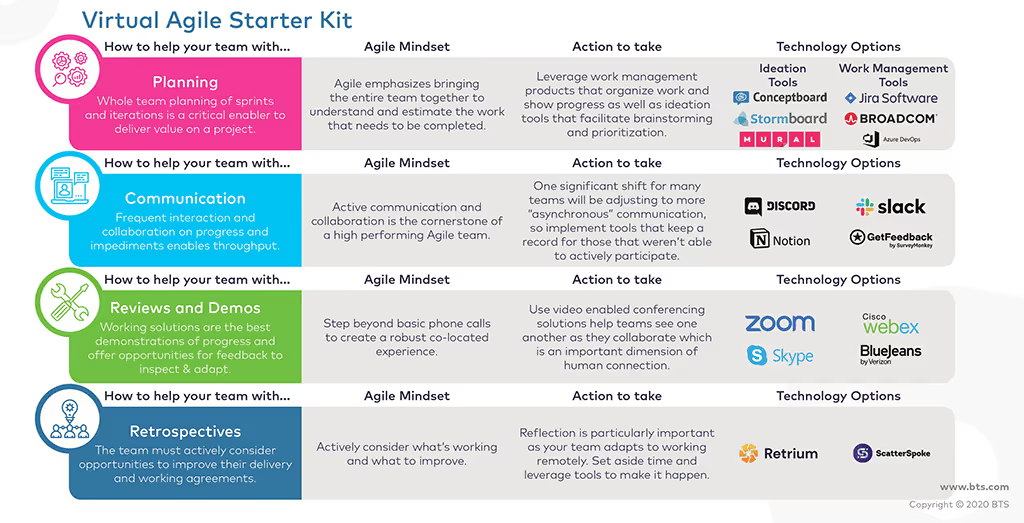
Create Your Agile Working Agreements
As teams shift to remote work, team members and companies will need to reconsider many of their working agreements. Team members will need to discuss how they want to engage using technology, such as expectations about responsiveness to messages and whether or not to always use video during video conferences.This might mean considering whether companies provide budget for high-speed internet, efficient and ergonomically appropriate workspaces, and how to support employee childcare needs. For employees, it will likely be necessary to create some working agreements in your household on how to manage noise levels, interruptions, take breaks, and the frequency of your visits to the pantry.Companies should also be reimagining their employee perks. Onsite gyms can become memberships to Peloton or Steezy, instead of onsite cafeterias, DoorDash or UberEats can offer alternatives. Companies can also start tracking the positive environmental impact of not having employees drive to work.
Are We Having Fun Yet?
Agile also emphasizes creating a work environment that includes having fun as a way to keep teams engaged. Ice cream retrospectives, jigsaw puzzle areas, and plushy talking sticks were signature features of Silicon Valley’s Agile teams, but in today’s environment, how do you insert fun into a virtual team setting?Try using easy to learn, team-oriented games accessible from phones, tablets, and computers such as one from Jackbox.tv. Another way to increase social interaction would be through a virtual pot luck with the team and encourage everyone to share what dish the prepared for the party. Another idea is a multi-player jigsaw game or creating a Guild in an online game like World of Warcraft. You can even invite a llama to a team meeting through Goat-to-Meeting and support a community farm. Encourage the team to offer their own ideas too.
Three Moves You Can Make Tomorrow
Agile can and will work in a virtually distributed environment. Here are three steps you can take to shift your team in this direction:
- Create your Agile technology stack: Check in with your team and make sure they have all the necessary tools to effectively work remotely. This means making sure your people not only have the right technology, but are also set up from an ergonomic perspective. Investing in keyboards, chairs, and lighting can create big returns in productivity for your people.
- Enable your team’s Working Agreements: Set aside time to create Working Agreements within the team on how you will engage with each other and technology. Be sure to set expectations on what you will be doing when and how frequently you will be doing it. Then, take these agreements and lead the charge on living these values.
- Lastly and most importantly don’t forget the fun! Invest in culture initiatives that make a difference for your people – whether it’s home exercise, meal delivery, or facilitated coworker bonding, ensure your culture remains intact and strong as you shift away from face-to-face.
The shift to remote working has already occurred in most organizations. But maintaining an Agile way of working while physically separated is a new challenge that organizations must face. Through the proper planning, communication, and working agreements, your organization can get ahead of the curve by maintaining your Agile way of working, even while virtual.

3 tips to get started in the novel world of hybrid selling
At a workshop on virtual selling for the Key Account Managers of a Fortune-100 technology corporation, Anna, a participant with over 20 years of experience said:
“I can’t wait for this to be over and to go back to visiting my clients as usual.”
In today’s environment, comments like these are not uncommon – reluctance to change is a constant of human behavior and the world of hybrid selling is challenging for even veteran sellers. At the end of a recent Sales Transformation updating the sales model of a leading pharma company, Luis, a sales representative, commented:
“In our work, face-to-face meetings are all you need, all these tools (you just showed us) are no good.”
The number of people resistant to virtual selling in the last several months has soared to new heights, but this is not a sustainable mindset for the future.
Virtual selling in today’s environment
Virtual selling is not new. What is new is the speed at which it is being adopted under the current circumstances – at some organizations, by force, and at others, with great reluctance, as in the examples of Anna and Luis respectively. Mindsets like theirs are present in all sales organizations and purchase departments and represent the innate human response to a perceived threat, fight or flight. Employees will either take flight, mentally checking out, experiencing denial, and waiting for the storm to pass, or they will fight, taking action to sell virtually, but longing for things to be “back to normal”. What these Salespeople don’t realize is that virtual selling is here to stay and that its adoption cycle has shortened. In fact, virtual selling can be a significant advantage if they get a few things right. Welcome to the world of Hybrid Selling, where Salespeople strategically mix face-to-face with virtual client interactions to boost their productivity and results.
Does this imply that, once the physical access to clients is back, Salespeople will hardly leave the office? Nope. Or that building a great business relationship with new and potential clients will happen online with the same effectiveness? Also, no.
Still, looking ahead to the future of Salespeople like Anna and Luis, it is easy to picture them being outperformed by more dynamic colleagues, those who keep using virtual selling as another weapon in their arsenal once the pandemic is over. But how?
3 tips for Hybrid Selling
Trends from organizations across geographies and industries where face-to-face meetings are now possible suggest that there are 3 things Salespeople need to define:
- Determine your “efficient” time. This is the percentage of your time that could be more productively used for tasks other than meeting clients in person. What if, instead of travelling around to visit clients, you used part of that time to look for new prospects? Or to attend more industry events? Or to craft better proposals? Or to think of insights to bring to the existing clients? You get the idea. This percentage of your time and what you use it for are highly subjective, though our early findings suggest that it should account for less than 20 percent of the total work time. To determine your own percentage of efficient time, think of how many hours in a week you wished you had available to be more productive through tasks other than face-to-face meetings. If you are still undecided go with 10 percent for now (four hours per week). Then make a wish-list of what you would use your efficient time for – two or three elements will be enough.
- Implement a set of criteria to determine what meetings can go virtual. Now, look at your agenda for next week and decide what client meetings should go virtual to free up your goal efficient time. There is no magic formula here, though a checklist of criteria can help you weight the pros and cons. To aid in this, organizations can create defined guidelines to help make this decision easier for Salespeople – e.g. all first meetings with new potential clients should be face-to-face, if the key decision maker for the client is attending through videoconference you should do that too, etc. In most cases, multiple variables come into play, which makes the decision more nuanced. Still, it is helpful to review a set of criteria / dimensions such as in the example below. (Note: the content of the “Face-to-Face” and “Virtual” columns is specific to each Sales organization and should be agreed upon internally).
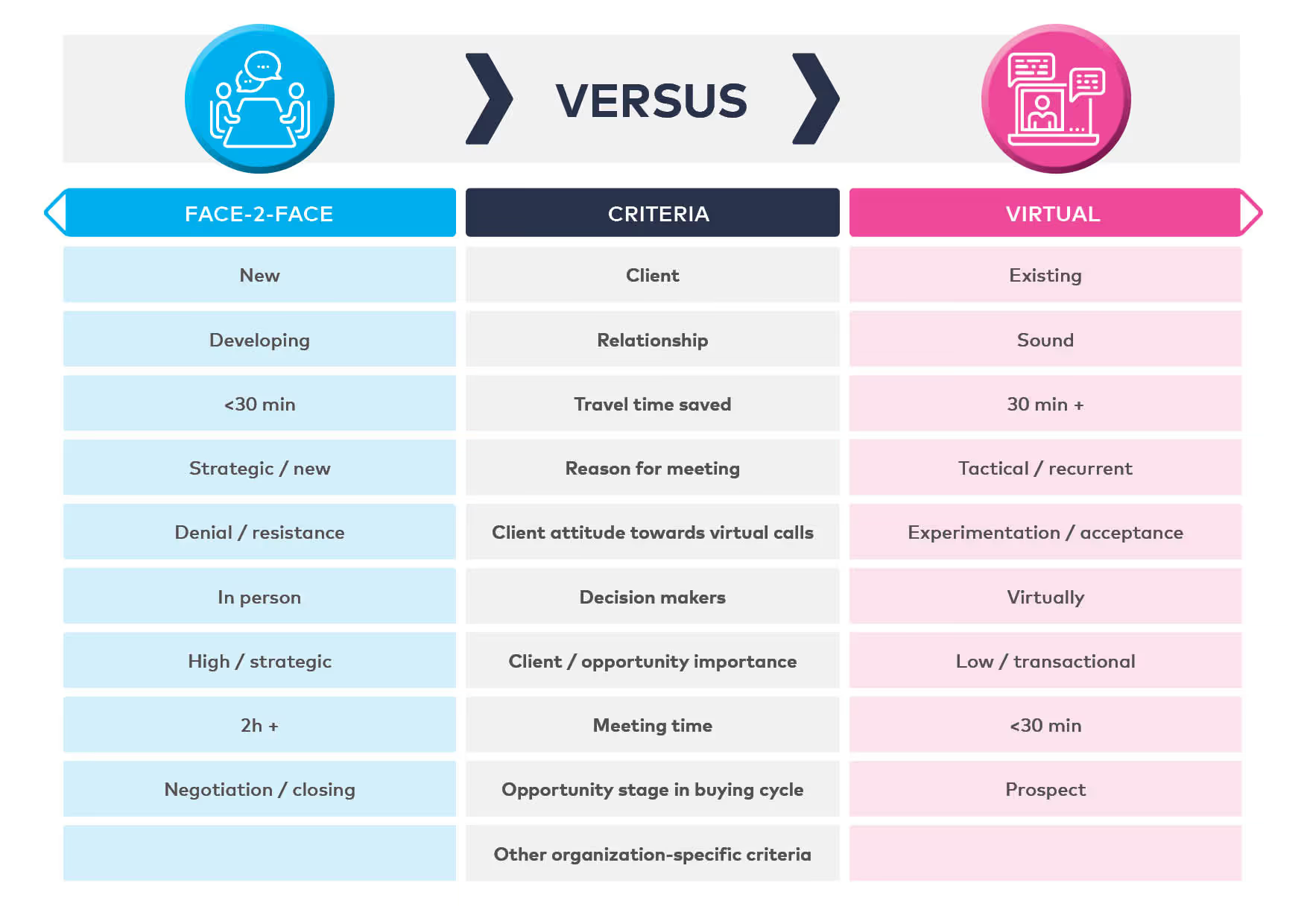
- Create a checkpoint plan to learn as you go. Steps one and two are a trial-and-error process: in the new reality most Salespeople are still learning how to engrain virtual selling into how they work. Leverage the process above once or twice before assessing your outcomes and make adjustments to create your own plan. Here are a few questions to help you get started:
a. Do you still need the same percentage of efficient time for the following weeks?
b. What quick wins are you observing, if any, in your new way of working? Are they scalable? What is their potential?
c. To what extent are you missing out on important face-to-face interactions? Include your clients’ feedback to get a full perspective.
COVID-19 has brought a shift in how Salespeople work and how clients expect Salespeople to interact with them. The good news is that traditionalist clients who would never take a virtual meeting in the past have now been forced to experiment with virtual communication tools and are more likely to accept some meetings as virtual interactions. Still, many seasoned account managers are dying to go back to the “good old days” of face-to-face meetings as soon as possible. These Salespeople are right to assume that face-to-face interactions will play a key role in the future, but their refusal to embrace hybrid selling is a big mistake – and will result in a missed opportunity for increased performance.
Who wants to be the next Anna or Luis? You have an opportunity to become a more productive Salesperson in the new normal, now it’s up to you to take it. If you don’t… others will.

How to make difficult people easier without changing them at all
The other day an SVP of Technology for a large manufacturing company, whom we’ll call Barb, told me she was elated.
In the past two weeks, she had completely turned around a difficult colleague. In fact, something quite important had changed between the two of them and it felt like a complete miracle to Barb.
Barb’s colleague is a woman we’ll call Leslie. Barb must collaborate closely with Leslie, yet she’s been a thorn in Barb’s side for years. Everyone finds her intractable, she gets in the way of delivering on due dates, and negatively impacts the customer experience with her decisions. She’s argumentative, doesn’t listen to other points of view, and only wants things done her way. Barb has found it overwhelming to constantly butt heads with Leslie. Yet together they run a large part of the organization and must work closely with each other, agreeing on both strategy and frequently on tactics. In working with Barb it was clear that she needed the dynamic to change, as it was exhausting her and taking away from the rest of her responsibilities and priorities for the business.
So, how did Barb work this magic with Leslie? How did she transform the person she dreaded speaking with into someone with whom she can have constructive discussions that feel easy and productive? How did she change her nemesis into a true partner in collaboration?
She didn’t. Barb did not change Leslie at all. However, she did change her experience of Leslie and, as a result, the relationship dynamic. In recent conversations and meetings with Leslie, they’ve been able to productively discuss challenging topics and, while they don’t always agree, they come to solutions they can both feel good about. The very conversations Barb has always dreaded are now enjoyable.
Since this situation had been going on for years, Barb found it helpful to step back and get an outside perspective on the situation. Our coaching conversation enabled her to find ways to question her own involvement in the dynamic and productively turn it around.
We’ve all worked with someone like Leslie. It can be quite frustrating to have challenging relationships with difficult people and they can cause tremendous drama and strain to those at all levels around them. It’s also common for relationships like this to create significant negative consequences to the business. And expecting people like Leslie to change – particularly since they have often gone unchecked and unchallenged for years – is a recipe in futility.
However, as we counseled Barb, you can take back control over these kinds of relationships and alter the course for yourself. If you find yourself in a situation like Barb’s, use these three tips for upgrading the dynamic.
- Challenge your own assumptions. If we’re honest with ourselves, we have a lot of assumptions about those we deem difficult. These assumptions may include things like: “she always wants to be right,” ”he doesn’t value my opinion,” or “she isn’t listening.” These assumptions create barriers and get in the way of our ability to give the other person the benefit of the doubt and connect with them to find common ground. When you notice these assumptions taking hold, instead ask yourself, “What am I assuming here? What might this person’s real intent be?”
- Take only what’s yours. I’ve noticed that often, in an effort to shorten interactions with difficult people, leaders will take on responsibilities or tasks so they can bring them to resolution their own way. And, if not taking on the responsibility, they may take on undue worry about it, or extra stress in planning around the interactions. Notice whether this is something you do. If so, you’re taking on the other person’s baggage. Instead, remind yourself in meetings, “This is not my bag to carry.” And be sure to let it go.
- Be direct yet open. The last thing we want to do with challenging colleagues is to be open. The instinct is to keep as much distance as possible. However, the barriers we create often contribute to the difficult dynamic. Push yourself to stop this on your own part. When you notice you are matching the closed nature of your colleague, instead use phrases like: “Help me understand…”, “I’m trying to understand this so I can be helpful…” and “Tell me more…” These phrases, that show your humility, can instantly unlock a dynamic and tear down seemingly impenetrable walls. You may find that when you seek to understand your colleague you may not be so far apart on issues and your colleague may be more open to understanding your perspective.
When you put these tips into practice, you create an atmosphere where others experience you as a restrained, composed, and inclusive leader who resonates with them. As you drop your guard, you let others do the same. Barb was surprised at how well this worked, and how quickly it helped her gain control over a dynamic that had been haunting her for years.
The key to building these habits is to celebrate when you remember to use them. Take stock after meetings to notice when you’ve used these strategies and to learn from missed opportunities. As much as we’d like our most challenging colleagues to change, even when they don’t change, you have great power to change the dynamic!

Does safety matter in your workplace? Learn the common mind traps in safety and how to overcome them
Safety in the workplace today is different from the past. Today, process improvements, safer designs, systems, and protective equipment are not enough. To create workspaces that are truly safe, companies must cultivate organizational cultures that prioritize safety by focusing on the behaviors and mindsets that enable lasting change.
Part of developing a culture of safety is determining the obstacles that prevent people from moving towards advancement. Beyond the proper physical tools or processes, ‘mind traps,’ or inherent subconscious ideas and beliefs that prevent people from achieving an ideal state, are one of the major barriers preventing organizations from improving their safety levels. Mind traps are difficult to identify and overcome because most people have a logical and rational basis for believing them.
Why is it important to identify mind traps in safety?
It is important to identify mind traps in safety because they have an impact on the way people communicate and behave in their day-to-day lives. If you believe accidents will still happen, no matter how much you try to communicate otherwise, your team will notice this belief and you will be passing on your mind traps to them. For example, if you believe that by sub-contracting an activity, it is normal for the number of incidents to increase, you will lower your guard and your team will do the same and thus increase the likelihood of an accident. In the end, mindsets impact and shape your behaviors and those of the people around you. The sum of these behaviors creates the company's safety culture.
To help you identify mind traps in safety in your organization, this list provides some of the most common mind traps people in safety experience.
Common mind traps in safety
Skepticism: This is usually one of the most difficult mind traps to overcome because people can use data to justify their beliefs. For example, if history shows that on average, one accident happens every year, it is reasonable to expect that it will continue, right? However, it is actually possible to eliminate accidents, but before this is possible, people must overcome their skepticism. Skepticism can sound like: "it is impossible not to expect any accidents over time – the data backs me up."
Complacency: This mind trap typically occurs when companies have experienced periods of significant progress, with indicators showing an absence of serious accidents and therefore improvements in safety. When indicators begin to reach a plateau, it often serves as a justification to make leaders believe statements like: “we have improved a lot in recent years, further progress is going to be very difficult.”
Criticism: This mind trap happens when people focus more on their surroundings rather than on how to actually improve themselves. This is normal when there are many things to improve and people don’t know where to start, when the job relies largely on third parties (collaborating companies, contractors), or when superiors do not always show coherence between what they do and say. Statements exhibiting criticism look like: “how do you expect me to set an example if my bosses don’t?”
Short-Termism: One of the main dilemmas in productive and industrial environments is the perceived tension between results and safety. The tension is only perceived because in more mature and advanced safety cultures, the two terms (results and safety) are not separated, nor do they contradict each other. This mind trap becomes accentuated in market environments that negatively affect income and margins, where naturally, the pressure for results makes the rest of the elements take a back seat. This thinking impacts what kinds of decisions are made, how they are communicated, and how they are executed. An example of the verbalization of this trap is: “safety is important, but sometimes it goes against efficiency.”
It is important to recognize that mind traps vary over time and are highly dependent on the environment in which you find yourself. There may be times when you think you have no mind traps, and then suddenly when facing a change of job or pressure for results, some are automatically activated. The nature of your day-to-day life greatly impacts your mind traps.
So, how do you face and overcome mind traps?
How to face and overcome mind traps
Identify them: Identifying the main safety mind traps and knowing which ones you are more likely to fall into is the first step to overcoming them. Leverage evaluations to easily identify individual mind traps.
Understand their impact: It is important to know the impact safety mind traps have on your behaviors and on the people around you – your team, your peers, your superiors, etc. Explore the impact your safety mindsets could have on the team.
Challenge them: Finally, define mechanisms to challenge yourself, your colleagues, bosses, and teams to break free from the safety mind traps. Become the devil’s advocate who questions the logical reasons behind the mind traps. For example, to combat skepticism, you might reference specific examples of long periods of time without accidents: “if we managed to spend a week, month, or year without any accidents in such an asset, we should be able to do the same with the rest of our assets, and for a much longer time, right?”
The ultimate goal of any business is to make money and therefore efficiency is key. However, to achieve such results in a sustainable way, safety must be integrated into your organization’s culture and way of working. This means identifying the mind traps in your organization and working as a collective to overcome them.
In an ideal state, at the more advanced levels of safety culture, there is a sense of community where everyone cares about each other. While the goal is still safely achieving business results (efficiency, income, margins), safety is not sacrificed.
In summary, to achieve significant improvements in organizational safety and wellbeing, it is fundamental that companies focus on developing a culture of safety. Key to any organization sustainably achieving their goals, a safety culture not only enables success but also ensures that everyone gets home to their loved ones safe and sound. To achieve this goal, it is critical to understand the mind traps within your organization and learn the mechanisms to challenge and overcome them.

Rapid Onboarding with Speed and Scale
While both are extremely important, they are often mutually exclusive—meaning you cannot have both—and companies must choose between them. Even when an organization strikes the right balance on both, sometimes a role has to be backfilled again and again. So, what’s missing here?

Why onboarding matters
Research by Brandon Hall Group (2015) indicates that strong onboarding processes can improve new hire retention by more than 80% and productivity by more than 70%. Therefore, it is critical that organizations get onboarding right—integrating new hires into the organization, teaching them about the organization's culture, strategy, products, services, clients, and procedures, as well as their individual role’s responsibilities.Most organizations have a general sense of what new hires need to learn and do early in their tenure to ramp up quickly and effectively. However, not all employees have the same learning needs, and not all people learn in the same way. Thus, while onboarding objectives and key learnings may be definitive across the organization, each individual’s specific learning needs and the methodology used to deliver the learning will vary from one person to the next.
Great onboarding in practice
Consider the onboarding process for new managers at Great Gains, a fictitious multinational financial services organization. Managers need to learn how their team fits into the broader company—the touch points, interactions, interdependencies, etc.Imagine two individuals who are new to the manager role at Great Gains. One is an introvert who needs to be intentional about social interactions, while the other is more extroverted and has no problems striking up conversations with people. The introvert will likely onboard best by experiencing a series of relationship mapping and networking activities, which encourages them to interact with others. By contrast, the extrovert will likely do better with a listening tour—meeting with stakeholders and listening to what they have to say without offering their own opinion.While differentiated, both approaches have the end goal of teaching the new manager about the organization and how their new team fits in. Throughout this process, managers will also build their network, which enhances engagement and collaboration during the experience.
How assessments fit in the picture
Assessments also have a critical role to play in the onboarding experience. Hiring and onboarding best practices leverage assessments for any of the following three purposes:
- Assessments help identify which individuals are best suited for the job efficiently and free from unconscious bias.
- Assessments help identify development opportunities and learning needs. Both of these are accomplished by measuring candidates on attributes (e.g., knowledge, skills, abilities) that are important for job success, and identifying whether these attributes represent strengths or gaps for candidates.
- Assessments can help identify elements of candidates' personalities or learning styles that have an impact on onboarding activities. In fact, the best assessments will not only provide insights to onboarding needs and plans, but they will also start the onboarding process itself during the evaluation experience by providing exposure to the organization’s culture and strategy.
The most efficient hiring and onboarding process accomplishes all three of these goals with a single assessment. What does this look like in practice?
What great onboarding assessments look like
Imagine you are reviewing a candidate and receive two reports, both from the same assessment. One describes the candidate’s strengths and growth opportunities, which are contextualized to the role’s requirements. This would be primarily used for hiring decisions. The second report describes the candidate's learning opportunities in more detail and provides a recommended onboarding plan covering the first 30, 60, and 90 days on-the-job. This report would be used after the hiring decision has been made to help facilitate an efficient and effective onboarding process for both the new hire and hiring manager. Producing both of these reports from a single assessment streamlines the hiring and onboarding process into an efficient mechanism for evaluating potential new hires and identifying next steps once they get in the door.Carefully designed, assessments can streamline your hiring process. One way to ensure your assessments are high-fidelity and deeply contextual is to partner with industrial-organizational psychologists who specialize in helping organizations gather information on people and make informed decisions based on data. These experts can help guide your hiring process and ensure you achieve your desired results.Using assessments to create a positive candidate experience have important considerations from both legal and psychometric perspectives. However, developed and used properly, they provide a great experience for candidates while adding significant value to organizations by helping them hire and onboard people both quickly and effectively.

BTS Client Stories: Interview with Silvia Ferrari, Head of Italy HR at The Walt Disney Company
Learn how The Walt Disney Company has shifted their approach to doing business amidst the COVID-19 crisis in this interview with Silvia Ferrari, Head of Italy HR, and Marco Rosetti, Managing Director at BTS Design innovation and VP of BTS Italy.

Revamping performance management
Teal Reamer, Senior Director, shares how BTS partnered with one of our clients to restructure and reinvigorate their performance management process in this video.

BTS and Clients win 19 Brandon Hall Group Excellence Awards in 2020
STOCKHOLM, SWEDEN and SAN FRANCISCO, CA – BTS GROUP AB (publ), a world-leading strategy implementation firm, won 19 Brandon Hall Group Excellence Awards in partnership with clients. These represent some of BTS’ best solutions delivered to a variety of clients including:
- ADSG
- Bayer
- HP
- Northwestern Mutual
- Schindler Group
- Anglo American
- Cepsa
- Marsh
- Salesforce
- TUV SUD America
- Aurizon
- China Minsheng Bank
- Medtronic
- STC
- Western and Southern Financial Group
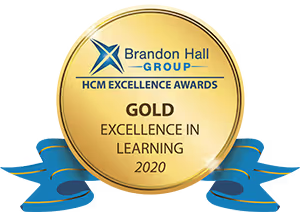
“Amidst this year of immense change, we are honored to be recognized for our partnerships with clients,”
said Rick Cheatham, CMO at BTS.
“Deep industry understanding and collaboration are foundational to the solutions we provide. We’re very grateful for our clients’ trust and look forward to more success in the coming years."
These awards include 13 gold, 2 silver, and 4 bronze, ranging from Best Inclusion and Diversity Strategy to Best Learning Program Supporting a Change Transformation Business Strategy.
“Organizations around the world highly value Brandon Hall Group Excellence Awards – so much so that we received a record number of applications in the middle of a global pandemic,”
said Rachel Cooke, Brandon Hall Group COO, and HCM Excellence Awards Program lead.
“The awards provide valuable recognition and validation of best practices in all areas of HCM at a time when they have never been more important to both employers and employees."
Entries were evaluated by a panel of independent, senior industry experts, Brandon Hall Group analysts and executives based on fit, design, functionality, innovation and measurable benefits. Find the list of winners here.

How do you hire a diverse candidate pool?
For decades, assessments have been a proven tool that organizations turn to for hiring and promoting the right people. However, did you know assessments can also be used to create more diverse and equitable succession? In this moment when organizations are thinking carefully about their talent pools, promoting, hiring, and developing talent inclusively is critical.
How do assessments help with inclusion?
Properly developed assessments take the human bias element out of the evaluation equation. By establishing clear, specific criteria, your organization won’t rely on your hiring manager’s “gut feeling.” Instead, you’ll be able to carefully calibrate your assessments to ensure they are actually measuring what’s required for success on-the-job. Validated assessments yield successful business outcomes for companies and produce fair and accurate results for participants. Not all assessments are created equal, so administering multiple assessments and simulations are an effective way to diminish adverse impact, meaning that doing so diminishes discriminatory effects on protected groups, thus promoting inclusion.Hiring talent isn’t the only time when assessments can be used to promote inclusivity. During the development process, once an employee is in a role and a manager views them favorably, the manager will likely help the employee access development opportunities and ultimately get promoted. However, without a formal assessment process for selecting who accesses these development programs or clear guidelines describing how they work, there is significant potential for bias. Managers informed about assessments learn that using the results of an assessment for selection is more reliable and accurate than relying on their “gut feeling.” This “gut feeling” is what typically results in managers identifying high potentials that look exactly like the existing management. Leveraging assessments can prevent this from happening and ensure that talent opportunities are directed to the right people.
Do all assessments help with inclusion?
Not just any assessment will work towards the goal of hiring a more diverse candidate pool. Assessments that are focused on the behaviors and mindsets needed to be successful on the job are critical. These types of assessments evaluate candidates for the skills that matter in their specific day-to-day working environment, such as diffusing a situation with an angry client or mentoring a junior employee. On the contrary, assessments that test for knowledge (popular examples include IQ tests or the SAT) are known to cause an adverse impact. Talent decisions made using those assessments negatively impact protected groups. Qualified candidates can be passed over because the assessment is biased towards individuals with specific backgrounds, which adversely impacts individuals based on race, color, religion, socio-economic status or otherwise that is not relevant to the job.
What does an assessment that successfully promotes inclusion look like?
A leading financial services organization wanted to evaluate how previous work experiences impacted new hires’ performance over time. For many years, the firm had prioritized hiring individuals with specific work experiences, assuming they would perform better in a financial services environment. However, they recognized that they were missing opportunities to hire non-traditional candidates.Thus, the firm hired BTS to create a validated assessment, which was aligned to the behaviors and mindsets that new hires need on-the-job. As part of the recruitment process, the firm evaluated each candidate with an assessment that simulated the job. Candidates who passed the assessment were hired, and the firm followed their progress over multiple years.This study produced telling results – the farmers, housewives, and unemployed candidates passed the assessment at equal rates. In addition, the assessment predicted multiyear success for non-traditional candidates.
In conclusion
Organizations have always used assessments to eliminate bias and create an objective way to evaluate candidates. At a time when inclusion is top of mind for most organizations, properly developed assessments remain the tried and true solution for selecting and developing diverse candidate pools.

Do you want to increase collaboration? How to break down team silos now
Business leaders know delivering value to customers requires all parts of an organization – sales, marketing, operations, planning, legal – to work together.
Each team has a part to play, but if they work independently rather than interdependently, creating that value can be inefficient at best and put at risk in far too many cases. Lack of cross-functional collaboration is a major impediment to successful strategy execution.
In a recent Harvard Business Review article, Sull and others studied 8,000 managers in more than 250 companies. When asked to identity the greatest obstacle to executing the company’s strategy, 30% of managers cited the “failure to coordinate across units.” Managers also said, “They are three times more likely to miss performance commitments because of insufficient support from other units than because of their own teams’ failure to deliver.”
A team might have great internal alignment, highly engaged team members, and all the other typically cited internal characteristics of a high performing team, but still fail to meet their performance targets because of a lack of collaboration with other teams. Teams do not work in isolation. They work in a network of teams. If you only look at your own team’s internal dynamics, which might be excellent, the lack of collaboration across teams is still going to put your team at risk of missing its performance targets.
So, how do you increase cross-functional collaboration?
Find out what is getting in the way
A good first step is to find out what behaviors are getting in the way. This isn’t always easy, as most team assessments do not measure the interactions and dynamics between teams. They only look at internal team dynamics. If you don’t look for or measure external dynamics, you will not uncover the sources of the problem and clues about what steps to take to increase cross-team collaboration.
When clients come to us with cross-functional issues, first we explore how the lack of collaboration is impacting their business objectives. Then, we often use our Leadership Team Performance Index (the Bates LTPI™) to uncover the behaviors that are helping and hurting the team’s ability to reach their performance objectives. This allows us to uncover and measure both internal and external team dynamics, because unlike other team assessments, the LTPI™ measures both. The LTPI™ is a validated 360 survey that not only asks the team leader and team members to rate the team on observable behaviors but allows other teams and key stakeholders to rate the team.
The LTPI™ model examines three dimensions (Culture, Credibility and Collaboration) and 15 facets of team behavior. One of the 15 facets is “Awareness,” which we define as “Being attuned and attentive to others' thoughts, feelings, emotions, and viewpoints; considering other stakeholders' situations.” In Awareness, the team gets feedback from other teams and key stakeholders on how well they are taking the needs of people not on the team into account. For example, the Awareness facet allows the team to get rated on items including how often they talk to people not on the team about how the team’s actions are impacting them. The LTPI™ also asks how well the team actively tries to resolve differences with other teams. These are two particularly critical areas to explore if you are having trouble with silos.
How data sheds the light on where to focus
To understand what is getting in the way of collaboration, you need to collect relevant, valid data, on the behaviors that make a difference in teams working well together.
Take the example of a cross-functional leadership team that is not trusted around the organization to collaborate sufficiently to deliver on their critical corporate business objective.
Mary was a senior officer at a large construction company and her division had just been tasked with building a new plant for their own company. It was going to be, by far, the largest infrastructure project in the history of the company. The executive team told Mary that they had significant concerns about the ability of her team to complete the project on time and on budget.
We met with Mary who was also very concerned about the lack of trust and collaboration among her team. Team members were skeptical of their peers’ capabilities. Everyone thought that they were brighter than everyone else and had all the answers themselves, so saw no need collaborate.
Mary agreed to have the team complete the LTPI™ survey. In addition to rating themselves as a team, they asked for and received feedback from other teams and key stakeholders.
Before sharing the feedback with the team, we asked them to identify five facets in which they needed to excel if they were to complete the new plant on time and on budget After they selected these facets, they examined their actual results.
It turned out that their strengths were not the facets they deemed as most important. And, their lowest rated facets gave everyone insights into what specifically was going on that was making collaboration a challenge. The raters from both the team itself, and from outside the team, felt that team members engaged in self-serving behaviors. They were not curious about anyone else’s ideas (which is not a surprise if every member thinks they are the smartest). They did not feel they belonged. They did not feel accepted or respected by teammates. And, as a result of these feelings, the team’s ability to make good decisions was stymied.
The results were not a complete surprise to anyone, but the data put these issues on the table in a clear, well-defined, practical way and made them discussable. They could no longer afford to ignore what they all knew. They knew they had to deal with their lack of collaboration.
Acting on the insights
The next step was to figure out what to do with what they learned. As a starting point, we facilitated a 2-day working session during which they created a shared vision for the team and learned a process for collaborative decision-making and problem solving.
The shared vision created a sense that they are all on the same team – that they are interdependent. And, they can only reach their own goals by helping others on the team reach their goals. Now, they had a reason to collaborate. They knew why it was necessary.
Facilitating collaborative problem solving, where they worked on solving real, actual problems they were facing as a team, showed them how they could work together. They began to appreciate and leverage their differences instead of dismissing them. They actually began to enjoy working together!
Eight months later the new plant was completed ahead of time and under budget. Trust levels with the executive team shot up. Even collaboration the next level down from the team went up as their leaders began to behave differently. Not only did the team’s collaboration increase, but it also increased for the network of teams below them.
As Stanley McChrystal said in his best-selling book Team of Teams: New Rules of Engagement for a Complex World, “Organizations must be networked, not siloed, in order to succeed.”
While this may be easier said than done, it can be done with the right set of tools and the right carpenters.
Click here to learn more about the background of the LTPI™.

Why bother with feedback in a moment like this?
As a manager, you may be thinking, “how can I possibly give feedback in the middle of a pandemic?” and “Why now?” Most are probably thinking, giving feedback is a huge risk. But in the current environment, doing so is more important than ever.

Why? Employees face a myriad of challenges daily – working virtually, maybe working less, operating different shifts. The way people work has changed significantly – and so have expectations. In the past, everyday conversations would provide an opportunity for managers to communicate new expectations and give feedback to direct reports, but in today’s virtual environment, those casual yet critical interactions have largely fallen by the wayside.
During this strange time, it is your job as a manager to keep your people engaged. Doing so requires you to clearly define what success looks like and how to get there. But for the average people leader, properly evaluating an individual’s performance, the ‘what’ and ‘how,’ is fraught with danger. The below scenarios highlight why:
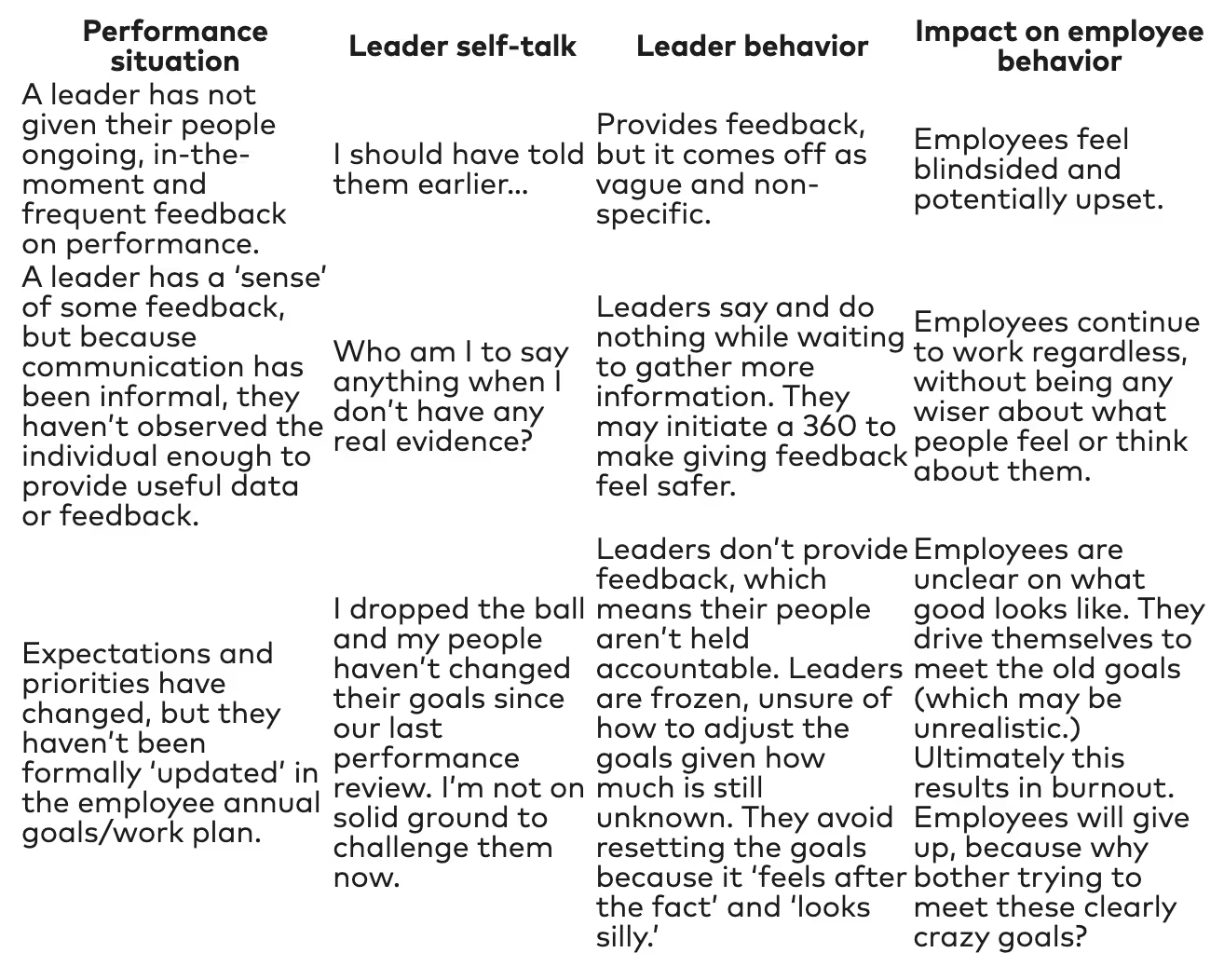
So what is the antidote? There are three key steps you can to take to make an outsized impact on your people:
1. Be Prepared
- Take time to reflect and take some notes about each person before you have your performance conversation. Use your calendar as a prompt to remember the key moments/interactions so your feedback is more data driven.
- If the feedback is serious and has consequence, make it very specific and direct. Write out a script if it helps you (and be willing to go off script, once well-rehearsed.)
- If the feedback is more developmental and less serious, acknowledge specific situations and leverage them for development coaching conversations. Invite them to rise above the situation and consider it from a broader view. For example, “Do you recall when you led the team meeting last week? We didn’t get through the full agenda and ran over by 20 minutes. Let’s set that moment aside specifically and think, what went well? What could have been better? What is the learning here? If you were doing the same thing next week, what would you do now?” etc.
2. Be Safe – Bring structure to feedback conversations so that even in the virtual context there is safety while providing feedback. For example:
- Give a frame for feedback that is positive and growth focused. In BTS we like to use “what’s working well” and “even better if…”
- Set aside ten minutes at the end of a team meeting and ask people to share their views on what went well, and what would be “even better if…” Using the chat feature is one way to get your introverted team members to contribute to the conversation.
- Set the expectation with your team that each one-on-one must include a moment for feedback, for both the leader and direct report.
- When setting up the quarterly/monthly reviews, set an agenda in advance that includes an explicit call out for feedback – asking people to reach out in advance of the meeting to get input from their peers.
3. Be Real:
- Go into every ‘tough’ feedback conversation with your head clear and your heart open. Going in with judgments, assumptions or heavy emotions could possibly make it a regretful conversation.
- Admit your mistakes as a leader to yourself first – without blaming or judging yourself, COVID-19, the business, or the situation. Know that you’re learning how to lead in a crisis too. The next step in being real is being willing to admit these mistakes to others.
- Adjust goals for the team as best you can, even if it’s later than you’d like. If you can’t change the goals for now, then share this with your team and decide when you will next review them.
In every organization, from top to bottom, everyone is still mastering feedback. A moment like this will expose gaps and make them look like chasms. Support your people with focused, consumable, digital and virtual development on giving (and receiving) feedback, so every leader out there can feel empowered and inspired, in every feedback conversation.

Will You Lead or Follow in the New Normal?
3 priorities to ensure success in remote working and learning
As the world surpasses 12 million recorded cases and 540,000 deaths from Coronavirus, it is becoming increasingly clear that recovery will be a slow and painful process. The COVID-19 pandemic has massively disrupted the economy and aggravated longstanding social inequalities, resulting in a resurgence of social justice protests.

Despite these massive shifts, some businesses and governments, whether consciously or unconsciously, still cling to the hope of a “return to normal” — normal markets, normal profit margins and normal electoral cycles. This is a mistake. The future will not look like the past.
Amidst the tragedy caused by COVID-19, organizations must find their footing and work diligently to create the new normal. The question is, in this unknown world, will your organization lead or follow?
Why corporate learning is critical
In the “new normal” caused by the pandemic, remote working and learning have already emerged as critical for success. Before COVID-19, only 33% of corporate training was done via virtual classroom or self-paced digital learning while 54% was still delivered in person. Yet in-person learning, as every university is finding out, is now a very risky proposition.
To survive in the new environment, businesses will need to reverse that balance and shift far more to remote learning. The traditional obstacle preventing companies from moving to digital learning was cost, though this had dramatically improved in the years leading up to COVID-19. The challenge now is that businesses in survival mode have already started cutting their learning and development budgets at precisely the moment when they should be maintaining or increasing them.
Today’s barrier is not just a delivery issue, meaning how training is delivered within corporations, but a prioritization issue – businesses need to reserve budget for training. The purpose of corporate training is to help onboard employees and support them in all aspects of their functions through continuous training. Because the pandemic is changing the very way in which business is done, corporate training is mission critical for people to perform at their best. Furthermore, the kind of corporate training previously carried out may be neither possible nor desirable today. Both the delivery and the content of corporate training need to be rethought and redesigned.
Surprisingly, the answer is not to just do more “online.” As work-from-home (or living-at-work) — whether loved or hated — becomes a permanent part of the new normal, companies need to help their staff explore and refine both the optimal work processes and their boundaries. This necessitates a tolerance for the unknown, a willingness to take risks, an acceptance of mistakes, and a dedication to experimentation. For the foreseeable future, the virus has made companies and employees alike pioneers.
Defining the new normal will require experimentation around three human-centered priorities:
1. Reboot communication and consultation
In the traditional manager-worker relationship, the worker’s experience often takes a backseat to the manager’s authority. This balance has shifted because the business’ survival now depends on front-line workers managing the daily risks and difficulties of customer interface under pandemic conditions.
As speed, safety and flexibility all become more important, managers need to truly listen to their front line, which is closest to the pulse of this rapidly moving situation and is — literally — running the risks. Any manager who does not truly listen to their front line is on borrowed time.
Agility and adaption to local circumstances are now more essential than ever. Businesses must innovate service delivery and customer service on the fly and week by week. At the same time, there is also now less margin for error with respect to safety protocols and quality standards.
The managerial impulse will be to go more rigid, with tighter one-size-fits-all protocols and processes. Instead, these layered challenges are best handled through iterative communication, feedback loops and consultative processes. As a number of studies begin to tease out the relationship between individual and group work, and the benefits of moderation, timing and bursts in communication, teams need to continually test out what works for them.
2. Accelerate diversity and inclusion
It is now well documented that COVID-19 and its knock-on effects disproportionately affect vulnerable populations — minority communities, the elderly, women, the poor. Therefore, part of the response to the virus must be to reverse the effect of these long-standing social injustices.
In remote learning, promoting diversity and inclusion must consider questions of equal access. Managers need to give careful attention to broadband connection, IT equipment, and even access to working spaces in the home.
Overall, less than half of all households (48%) have what the 2018 US census defines as “high connectivity”: a laptop or desktop computer, a smartphone, a tablet, and a broadband Internet connection. According to the same census data, minority households were the least likely to have high connectivity. Low-income households were far less likely to have high connectivity than high income households (21% of households with an income under $25,000 v 80% of households with an income of $150,000). The rural/urban divide also compounds this gap: only 54% of low-income rural households had high-speed broadband versus 96% of high-income urban households. There is work to do.
COVID-19 is also eroding decades of hard-fought gender gains in the workplace as women lose jobs at a faster rate than men. Remote work and corporate training need to be redesigned to ensure they do not disadvantage caregivers — mainly but not exclusively women — working out of the home. The overall understanding of remote work and training needs to evolve from a benevolent tolerance of the “toddler run” and the “potty break” to a new reality in which comprehensive and tailored child care are seen as critical.
Above all, businesses will now need to work even harder to reach out and recruit, retain and promote a diverse workforce at every level.
3. Act with empathy (and expect it from others)
No matter how tech savvy you may be, all workers have been pushed to use and rely on technology far more than in the past. As companies and managers navigate the physical changes to working in the pandemic, it is important to remain attuned to the psychological and emotional needs of employees and customers.
COVID-19 has heightened the challenge of maintaining a work-life balance, and employees may need more flexibility from managers to mitigate this issue. More seriously, there are many for whom home may not be a place of comfort and safety. Awareness of these issues is the mandatory “new normal” baseline for managers.
For example, the virus has disproportionately affected older citizens. Older learners and workers are not only getting sick at higher rates, they are also more likely to be challenged by the increased use of technology and new ways of working, so care must be taken to ensure they are not left behind. Corporate remote learning and operations need to extend beyond one-size-fits-all learning models to address these needs, as it started to do with addressing accessibility requirements.
Solving these problems and the many unknowns still over the horizon will require genuine empathy — felt and acted on by those in leadership. Regardless of the business age and size, success will also require a spirit of entrepreneurship and experimentation.
Contribute to the new normal or be consumed by it
In times of change, the data shows that those who act fast and engage firmly with the new reality will do the best in the long run. Organizations that fail to step up and contribute to formulating the new normal will be left to embrace the reality created by others. If you’re not at the table, you’re probably on the menu.
As they pivot, managers will need to embrace a posture of humility to help their people see success. If you think you know what the new normal is, think again. None of us do. Listen to those around you, care for them, trust them, and they will help you create the future. We are all pioneers now.

The Office of the (Near) Future: Remote-First Work
Surprised by your employees’ productivity working from home? You may be considering how you can capitalize on the transition that’s already occurring and accelerate the shift to a remote-first work environment. However, before you do, there are some critical lessons that you can learn from businesses already working in a virtual environment.

Reimagining the office
As human beings, it is difficult to think about the future without viewing it as an incremental improvement over the present. In today’s virtual environment, most organizations are attempting to recreate everything that was happening in an office environment and do it online. This is a common mistake that happens all the time – but it’s not actually the most effective way to transition.
In addition, many employers have invested significant sums of money in corporate campuses to improve collaboration. As companies have invested more in keeping people engaged at the office – leaders are left wondering how to walk away from these major investments and what takes their place.
So, how do you transition to a remote-first environment?
1. Reimagine don’t recreate: List out the assumptions you have about in-person work and provoke each one of them, reimagine what those tasks and activities might look like in a virtual work environment.
For example, many assume that: “if we become remote-first, we’ll never see each other again.” If in-person interaction is critical for your company culture and productivity, repurpose the office environment as a co-working space for employees to collaborate with each other when they need it. This opens opportunities to use smaller spaces that are closer to concentrations of employees, for example a co-working space in the city and an option for those in the suburbs – shifting away from a more traditional corporate campus.
In the COVID-19 environment, this requires some thoughtful consideration on what types of interaction need to occur in person and which interactions can happen over the phone or video chat, but there is no need for absolutes. Provide your team with options to meet in person if they prefer and can do it safely.
What does this look like in practice? A great example to look at is Automattic - a distributed digital publishing company (think WordPress and Tumblr) with over 1200 employees spread across 77 countries and 93 different languages. While a fully remote organization, the company still values in-person interaction, which helps them to maintain their culture – they have simply flipped the standard ratio (mostly in-person and infrequently remote) to mostly remote and infrequently in-person.
2. Lead the change: If leaders are still in the office, the rest of the company will aim to come into the office – if you want to be remote-first, leaders must commit to being remote themselves.
Face time with senior leaders is often considered an important rite of passage for corporate cultures, and the more time a leader spends communicating with you the better chance you have of being noticed for a promotion or a high-impact project.
In a remote-first organization, leaders can create a level playing field for a distributed workforce that rewards outcomes and not the person who is the first one in, last one out, or sends emails at all times of the day.
In shifting to remote-first, your leadership team must model the way they want employees to act. This means the leaders must also go remote and build new communication habits in their organization to allow for asynchronous collaboration and updates.
We are going fully remote first at Quora. Most of our employees have opted not to return to the office post-COVID, I will not work out of the office, our leadership teams will not be located in the office, and all policies will orient around remote work. (1/2)
— Adam D'Angelo (@adamdangelo) June 25, 2020
3. Flip the ratio of in-person to virtual interactions: In-person interactions don’t go away in a remote-first world, they are more targeted and thoughtful. Provide stipends to employees for team meetings, one-on-ones, and other interactions and set guidelines on when in-person interactions should happen and when they are not needed.
People are surprised when I say this, but I think in-person is really key. And so we just flip it, so instead of saying you have to be around your colleagues 48 weeks of the year and do whatever you want for a month, we say be wherever you want for 48 weeks out of the year and for three or four weeks a year we’re going to bring you together.
- Matt Mullenweg Automattic CEO
Remote-first companies need to set clear expectations and guidelines for when teams should come together (in a co-working space, coffee shop, or elsewhere) and limit those interactions to ones that add more value being together in-person than virtually – flipping the old co-location ratio as Automattic has done.COVID-19 has challenged common biases of where work can be done most productively, and you’ll find that teams (equipped with the right tools and resources at home) can be surprisingly productive without being co-located.
And who says you can’t have office perks while at home? It can be as simple as repurposing the money invested in your latte machine to provide a stipend for a green screen, dual monitors, microphones, and a high-quality web camera (and maybe an UberEATS subscription for some snacks when desired).
4. Create a new rhythm of communication: Asynchronous communication involves a new communication rhythm — repurposing emails/check-ins and other meetings and creating new norms for how information is communicated and how others can contribute to building on ideas from other parts of the company.
Leaders should consider building a new asynchronous rhythm of doing business. Instead of emails and calls (which in a distributed workforce are tough to schedule across time zones) – consider a blogging system like what Automattic uses called P2s to document progress on projects.
P2s are posts written every day by employees to summarize what they have been working on, the problems that they might have encountered, and the discussions they had that day. If you think about the purpose of in-person meetings, whether face-to-face or on Zoom, this is typically what people are doing – unearthing hidden information from the organization to see what folks are working on, reach group decisions and find ways to collaborate.
By documenting what is happening on P2s, it has become a cultural norm at Automattic for all employees to read P2s and uncover what is happening around the company. This communication method creates a transparent organization without FOMO (fear of missing out) when not included in a meeting or copied on an email chain. Using an internal search index, you can look up P2s and follow certain topics (like Google Reader) to stay informed on progress.
5. Honor what made your culture great while continuing to grow: Continue to honor what makes your culture great, remote-first doesn’t mean you have to lose it – it offers new opportunities to build your culture and invite more talent into your organization that you previously may not have had access to.
If you ask any leader what makes their organizational culture great, you will likely get a range of responses from company to company. Some companies value a strong safety and compliance culture that enables them to reduce risk in their work environment, while others value an entrepreneurial environment where they are afforded creativity to take on challenges. Employees on Glassdoor rarely say that office perks make a company great – it’s about the people, work environment, and opportunities provided.
Those same positive attributes can be reimagined (not recreated) in a remote-first environment. It can be as simple as creating space on employees' calendars for “making time.” Making (or Maker’s time) is a concept created by Paul Graham, founder of Y Combinator, which advocates for blocking a large portion of each day for individuals to do focused project work without fear of interruption or task-switching – for example blocking each morning until 12:30 PM for individual work.
By reducing the need for emails and check-in calls, it creates more dedicated work time for employees to creatively solve challenges and is a great example of reimaging the virtual workplace vs. recreating interactions we typically had in person when located next to each other.
To encourage comradery, you can promote small team or one-on-one interactions amongst employees by providing gift cards for lunch or coffee so employees located near each other can meet and network. Another option is for leaders to participate in targeted, fun interactions across the company – for example, virtual trivia nights, a virtual scavenger hunt, or hosting a “bring your kids to work” on a company or department-wide Zoom call. Anything to create a positive environment representative of your company culture.
Remote-first work allows organizations to honor and celebrate what made their office cultures great and re-invest time and resources to continue improving on that culture forward in a distributed work environment where you have access to more talent outside of your city.
So, what’s next?
The current work environment offers both challenges and opportunities. Shifting to a remote-first permanently can make sense for organizations moving forward that have seen the benefits of this shift but doing so doesn’t need to be a daunting challenge. By learning from organizations who have been doing this and doing it well for years, your organization can meet the challenge of the future, while preserving your culture, accessing new talent and reimagining your work environment to unlock productivity.

Advice from a television news anchor: how to “leap through the camera” with virtual presence
These last few months have given us all a trial run as news anchors.
We sit in front of the camera on our computers and chat with the audience just like a news program. Though many of us came in the world of virtual meetings kicking and screaming, we have acclimated. Our mobile phones are second rate. Virtual video has won.
Now that we are living in the virtual world, we’re starting to develop a more discerning eye. We judge what we see, often harshly. Sure, it’s been fun to laugh at cute puppies and unexpected guests in the background during virtual meetings, but the novelty of the faux pas is wearing off. Many people are thinking, “It’s time for me to up my game and ‘go pro.’”
One reason for a flourishing interest in showing up with a stronger virtual presence is that virtual is here to stay. Companies have started rethinking the need for so much office real estate. People are dispersed anyway. Commuting in most places is hell. Travel is expensive, and it takes a heavy toll on the mind, body, and soul.
Even with all their flaws, virtual meetings will still be convenient when offices open again. You can wear sweatpants, help your spouse make dinner, all while being very efficient at work. Good virtual meetings improve teamwork and can build strong bonds. A well-run meeting can democratize debate, encourage participation, foster diversity of thought, and speed work to get more done.
You, on the small screen
Given all these changes, it may be time to take stock from a communications professional’s perspective. Survey your personal “studio” – your home office – that stolen space in the guestroom, or corner of the dining room. Ask yourself, “What’s the message I’m sending? How does this place reflect on me as a leader and a professional?” Empty walls, bad lighting, layers of family photos on rickety shelves, and dead plants are not leadership brand builders.
Then, take stock of the VIRTUAL you. Who shows up on the screen? Each meeting with a colleague, client, investor, prospect, analyst, or an entire team is an opportunity to make a powerful, lasting impression. After spending two decades of my career in television news, I can tell you that the thought you put into this is not just a nice to have, it is a survival skill. You must be ready for the game. As I used to say to my friends who wondered how we met our deadlines, “Six o’clock comes, whether you’re ready or not.”
Not a natural-born skill
Being on camera is not a natural born skill. Professionals spend years experimenting to get their on-camera presence right. Through trial and error, they develop polish and their own authentic style. However, you can adopt habits that work if you know a few rules of the game.
Showing up in the little video square is obviously different from standing at the front of the room, though good presenters have habits that do translate. Eye contact, facial expression, small gestures make a difference. Mastering the “little screen” can be easier if you know the rules of the virtual road.
Six strategies from the news desk
In that spirit, I offer 6 tips from the news desk that can help you bring your best self to the virtual world, communicate effectively, and show up ready to shine.
- Ready or not, it is “showtime.” On TV, when the red light goes on, professionals set aside whatever is going on in their lives, and I mean impending divorce, children falling off bicycles, and general life mayhem. When the camera is live, it is “go time.” Leave life behind. You cannot be distracted. You have a job to do.
Showing up in the moment reflects on your leadership and your professionalism. If you come unprepared, missing the right documents, fumbling for the agenda, and trying to locate a spreadsheet, you are not ready for prime time. It’s okay to give others grace for this, as a lot of people we work with are in back to back meetings. As a leader, though, you set the standard. Make a habit of collecting yourself a few minutes prior to each meeting. End meetings early, take a break, prepare, and be on time and focused for the next one. - Leaping “through the lens.” Your computer is an inanimate object. When we look at machines, we tend to be less animated and more “machine-like” in style. To go pro, you must overcome this tendency. Look at the dot that is your camera, make direct eye contact, and imagine you are there in the room. Really “see” people on the other side of the lens.
Sometimes it helps to remember the people on the other side of the camera are not just colleagues, clients, or prospects, but friends. Take time to ask how they are doing. Listen and respond appropriately. Let the conversation breathe. Do not allow yourself to be distracted by email or your spouse asking you whether you picked up the mail. Show people you are paying attention by conveying emotion through facial expression and vocal tone. Let them know they have 100% of you right now. - Warming it up. Along the same lines, warm up the meeting by taking responsibility for welcoming others and setting the tone. Imagine you’re hosting your own show. Give some thought ahead of time about topics that will warm up the conversation before you begin, even for just a minute. Make the meeting more than a transaction.
This is important because working virtually you don’t have available to you all the usual ways of warming up conversation in the room: arriving at an office, offering coffee, catching up on the weather, are all out the door in the virtual world. The best television anchors consider themselves hosts. They invite intimacy with appropriate small talk and curiosity about others. This rapport builds trust, bridges the technical divide, and makes you a memorable presence in the virtual world. - Virt-U-al YOU. The virtual you is the best version of you in a small screen. How you appear in the frame matters. There’s also the question of when to stand and when to sit. Sitting works most of the time, so get a good chair that allows you to sit up straight, employing pillows or props if you need them to be comfortable. Slouching is disrespectful. For formal presentations, consider standing. TV anchors have a variety of places on set where they can do a demonstration, show you a map, share a visual. Standing also energizes you and communicates respect. Consider standing for a keynote, analyst day presentation, board or investor meetings and sales finals.
- Your virtual wardrobe. Sweatpants and sneakers, check. Fine for most of the time (except when standing on camera). You may be one of those people who just feels more professional getting dressed for your day and that’s great. What matters for everyone is what is happening from the waist up. I worked with a co-anchor who sailed his boat every day, came in around 5:00 pm, washed his hair in the sink, threw on a coat and tie and was ready to go. No one in our audience knew he did not own a pair of dress pants.
The key is to pay attention to your “communication center” – essentially, your face, head, and shoulders. Think about where you want people to focus – on you. Clothing should be attractive and simple. No distracting patterns or oversized jewelry unless fashion or creativity is your stock and trade. No one wears ties except for formal presentations anymore, but men are the worst offenders when it comes to casual. Wearing your Saturday fleece on a virtual meeting says, “I would rather be watching Netflix.” Make an effort. It is a sign of respect for your audience and your people. - Ad lib and be liberated. News anchors go with the flow of the news effortlessly even when off script with breaking news because prior to the broadcast, they have read up, talked with sources, prepared for interviews, and reviewed the producer’s scripts. This preparation is part of the routine and gives them the confidence to improvise when they need to.
Just because you’re on the small screen doesn’t mean you can skip rehearsals or preparation for presentations. It’s even more important because sitting alone with the camera is unforgiving if you fumble or get flustered. Take the time to practice with PowerPoint, study your notes, and have a game plan. If you have rehearsed, are on top your game and well prepared, you’ll be liberated and able to ad lib when the moment arrives. You will never have to let them see you sweat.
As we have learned from the news anchors who make this look so easy—it is possible to embrace the camera and develop the habits that help you can connect with any audience, inspire them, and energize the virtual room. If you take the opportunity to learn the lessons from the news desk, you’ll be ready to “go pro” in your next virtual meeting.

Are your leaders ready for the next disruption?
The speed and impact of the COVID-19 pandemic took most leaders and organizations by surprise. While this disruption is a dramatic outlier, leaders need to recognize that disruptions happen all the time. Some are unexpected, like COVID-19, while others are not. Businesses often disrupt themselves to innovate or react to new market demands. The bottom line: planned or not, disruption is here to stay. So how will you prepare your leaders for the next one?
When does disruption occur?
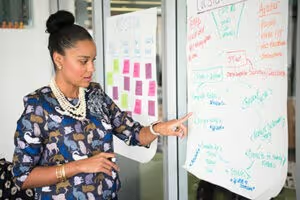
Understanding when disruption happens is a critical first step in preparing for it. Most disruptions are smaller than COVID-19, yet still have a significant impact on the business. Often self-initiated, disruptions occur when the business sets a new vision and goals or makes changes in strategy and operating models to adapt to marketplace forces. Culture transformations, acquisitions, mergers or other organizational change efforts also create disruptions. Frequently, more than one of these changes is happening at a time.
Why is disruption occurring more frequently now than ever?
In today’s environment, change is the new constant. Since the end of the twentieth century, the advent of the Internet and rapid advancements in technology have dramatically increased globalization and connectivity, accelerating the rate of change beyond anything seen before. In turn, this has shifted how leaders must approach change.
What did change look like before?
In the past, change was viewed as a straightforward process – a controllable event with a beginning, middle and an end. To prepare for change, leaders would plan for it, manage it and course correct to get to the end and be done with it.
Leaders embraced the mindset that with change comes risk. They believed change must be controlled to mitigate the various risks involved. This mindset allowed leaders to create the illusion of steadiness and calmness – something that historically came after change. This is called the stability mindset.
Change is uncomfortable for most people, so leaders often try to use the stability mindset to make their teams feel safe and secure, which enables them to perform at their best. However, in today’s business environment, this natural reaction is misguided. Persistent change means that treating change like a fixed set of events doesn’t align with reality.
Leading in today’s world
To be successful, leaders are now required to embrace the new belief that change is good fortune. Leaders must hold an opportunity mindset, embracing change as ongoing and necessary for growth and cultivating the belief that opportunity only comes with change. This new mindset turns on its head how leaders of the past perceived risk. Instead of associating risk with change, today’s leaders must understand that risk actually comes from NOT changing and remaining with status quo. Inertia causes organizations to lose ground and fall behind. Thus, change is not only necessary, but advantageous for businesses to adapt. Leaders who embrace an opportunity mindset can navigate change with a sense of confidence rather than hesitation or doubt.
Mindsets matter
The way leaders think about change is one of the biggest determinants of how successful change will be1 . Therefore, it is critical to examine preexisting organizational and individual mindsets about change. Typically ignored, these can provide critical information to help unlock transformation.
To help identify your individual and your organization’s mindset towards change, below are four different types of executives and organizations. Each example profiles an organization’s underlying relationship with change and identifies whether it embraces a stability or opportunity mindset.
Change Receivers:
Leaders who perceive change as pushed upon them feel a lack of control, resulting in a flight response. When leaders are in the habit of being a receiver of change, they are passive in their reaction and feel out of control, as if there is nothing they can do to prevent what is happening. Leaders with this response to change abdicate their own authority. The change receiver holds a stability mindset.
For example, a high-tech manufacturer set in motion a significant go-to-market global transformation. The changes brought by its new strategy shifted expectations for sellers, but these changes also touched product development, supply chain, customer support and finance. Senior leaders just below the c-suite reported that the “decisions are made by HQ” and even referenced “looking up” for direction as a behavioral norm in the company. These leaders tended to:
- Wait for direction or decisions from others before moving forward
- Refrain from taking action in new situations to avoid conflict
- Escalate decisions, assuming such judgements are “above my pay grade”
- Accept decisions or direction even when they don’t think they will work
Change Resistors:
Leaders who try to maintain their power and authority by pushing back against change. These leaders strive to protect the past by resisting the change with the belief that it will go away in the near future. Leaders will freeze, choose inaction or only take actions that they can control. Resistance can take many forms, such as questioning the authority of the change leaders, seemingly agreeing and then doing nothing, and citing reasons why the change does not apply to them. These leaders hope to wait out change. The change resistor holds a stability mindset.
For example, a global manufacturing company would routinely rotate high-level senior leaders as part of their development plan. During the rotation process, these senior leaders sometimes faced resistance, skepticism and inaction from their new team of leaders. The local leaders knew from their past experience that they could passively resist the new direction and continue doing what they were doing because their new senior leader would change again soon – as would the direction. In this case, resisting change was the leaders’ best path to stability. This led them to:
- Refrain from speaking up, even when holding an alternative perspective that would provide needed insight
- Bring up reasons that something could not be done based on precedent or history
- Agree, and then find reasons not to execute on the stated commitment
- Poke holes in the plan as a means to avoid taking action
- Criticize change efforts without offering alternative ideas or help
Change Controllers:
Leaders who believe that they can control change and its effect around them. These leaders create detailed plans, launch initiatives, manage events, or do anything that gives them a sense of control. Why is this a fight response? Taking action feels good, but even when executing the most well-crafted plan, a leader will encounter unexpected circumstances.
If the leader believes they have controlled the change with their plan, then obstacles and missteps are failures. When this happens, there can be a tendency to ratchet up reporting and accountability, micromanage or even to seek to blame for mistakes or lack of progress. This behavior gives them a sense that they are managing change. They often believe that it is up to them to help get their team or organization “through” the change. The change controller holds a stability mindset.
For example, an Oil and Gas organization recently launched a new strategy. As part of identifying what was needed to move the strategy forward, they reviewed critical processes designed to aid strategy execution. During the review, the senior team realized that their approach to quarterly business reviews would hurt progress toward their strategy rather than moving it forward. The senior team determined that their detail-oriented questions were “backward looking” and provoked ineffective behaviors rather than learning and forward progress, so they completely changed it. These change controllers tended to:
- Make decisions independently with limited input from colleagues
- Seek information that supports their personal agenda
- Ask detailed questions about why progress is slow or results were less than planned
- Give detailed instructions on what to do rather than inquire about what has been tried
- Discount obstacles raised by others to keep to the original plan
Change-Ready LeadersTM
Leaders who see change as normal, constant and the source of new opportunities. Leading change from this perspective requires a new set of great behaviors from leaders. A leader can choose to lead change rather than avoid it, resist it or try to control it. To lead change means leaders are scanning the environment, anticipating what is coming, and seeing opportunities where others see challenges. In some cases, it means thinking through a Plan B (and Plan C) because they know that Plan A will not work perfectly. Leaders focus more on aligning their teams on direction and purpose rather than telling people what to do. They create an environment where people learn, adapt and change together. The change-ready leader holds an opportunity mindset.
Change-ready leaders also focus on gaining emotional agreement from teams around the change being implemented and the reasons for doing it. This is a departure from the common idea that leaders only need to focus around explaining the “why” behind the change when communicating to individuals. Alignment around the vision is more beneficial for teams so they become invested in changing rather than focused on the why behind the change. Great leaders understand that letting people find their own reason for change and developing that understanding is critical to building trust.
How do great change-ready leaders lead? They try new tactics and implement new leadership competencies that they may not have used before. These competencies are brought to life in the form of behaviors, which are a result of having a different mindset and response to change. A change-ready leader holds an opportunity mindset and believes that change is expected, normal and constant. In order to make that mindset come alive, great change-ready leaders:
- Rally others around the positive reasons for continual change
- Accept the conflicting views, assumptions and feelings of the team
- Promote the company’s purpose while simultaneously balancing the reality of today and future possibilities
- Engage diverse teams to work together on difficult challenges while holding them accountable
- Encourage the team to accept change, paradox and complexity as facts of life that yield new opportunities
While these change-ready leader behaviors may seem to be common across companies, they are actually represented uniquely in each organization. Mindsets are universal across organizations, yet their application is contextual. This means that great leadership is not a carbon copy across all companies – an organization’s culture plays a significant role in terms of what makes a leader great on the job.
To become change ready, it is critical for leaders to understand and codify both the “how” and “when” to lead change within the context of their own organization. This works best if leaders can define what great change leaders do differently relative to average leaders in the form of capabilities and behaviors. In tandem with change leader capabilities and behaviors, identifying the pivotal moments where leaders need to demonstrate the capabilities and behaviors is an excellent tool for development.
Identifying these pivotal moments allows leaders to immediately recognize the situations where, by changing their actions, they will have the largest impact..
To prepare for the next disruption, leaders need to uncover their current response to change, understand why and how it served them in the past, and then shift to seeing change as a new constant. Once this change in mindset happens, behaviors will shift consistent with being a change leader within the context of their organization. Adopting a more productive relationship to change during the COVID-19 crisis will help leaders navigate the current situation and come out of it more prepared and confident for the next disruption. With tools in hand, perhaps they will even seek opportunities and create disruptions of their own.

BTS Sales Index - June 2020 Update
We created the BTS Sales Index to give a simple and easy-to-understand predictive monthly metric that gives enterprise leaders the right vantage point by which to view their critical business decisions.
BTS Sales Index June 2020 Update
-3.8
BTS Sales Index June 2020:
105.0 (-3.5%)
May 2020* in the Economy
- Aggregate revenue of BTS 1000 decreased for the third consecutive month from $3.384 trillion in April to $3.265 in May, declining by $119 billion
- Employment rose by 2.5 million jobs in May, the largest monthly gain in new jobs since the BLS started tracking the data in 1939
- Leisure and hospitality, food services and drinking places, and construction sectors saw the highest increases in employment
- The unemployment rate improved from 14.7 percent in April to 13.3 percent in May
- Even with a 17.7 percent increase in retail spending in May, major retailers J. Crew, Neiman Marcus, and J.C. Penney declared bankruptcy
- With many companies and businesses operating at half capacity, expect more long-term effects
*the June update is reflective of May 2020 data
Why
Line of business and sales leaders tasked with making strategic decisions don’t have a good measure of confidence when deciding to ramp up production or invest in customer relationships. Quarterly GDP numbers and the S&P 500 paint two different pictures of economic performance, the former too slow to incorporate new data and the latter too likely to overreact to investor sentiment.
We created the BTS Sales Index to give a simple and easy-to-understand predictive monthly metric that gives enterprise leaders the right vantage point by which to view their critical business decisions.
What
The BTS Sales Index represents the aggregate total revenue of the 1,000 largest publically traded companies in the US in one simple to understand number.
How
As mentioned above, the BTS Sales Index is comprised of the total revenue of the largest 1,000 publically traded companies incorporated in the US. Every month, we collect the total revenue reported by these companies and run the data through our custom-built indexing tool. The index uses the total revenue of the BTS 1,000 companies at the end of the second quarter of 2013 as its baseline because the economy showed signs of stable recovery. Unemployment was back to normal rates, housing prices remained steady, and stock prices were back to record levels.

Why a coaching mindset could be essential for leading during uncertain times
This article was originally published in Thrive Global here.
It’s up to leaders to cultivate the right coaching mindset to lead their teams through this health crisis.
This time of unprecedented change leaves many feeling overwhelmed, stressed, and frustrated. For leaders, however, it’s now mission-critical to dial up support for your team members. Bringing a coaching mindset to the way you lead them will help you actively accompany your people through these extraordinary and uncertain times.
To leverage the power of a coaching mindset, you’ll need to believe people have potential and can grow, trust that others will rise to do their best when stretched, and embrace curiosity rather than jumping in to fix others’ mistakes. That’s not to say there aren’t moments when fixing is important. But now more than ever, a coaching mindset will help you empower your teams and allow them to see things in new ways, creatively adjust to the new normal, and foster meaningful connections.
These factors are all crucial for business success and personal well-being.
Cultivating a Team Mentality Remotely
Trust, safety, and comfort are important for any team — remote or not. And if we really think about it, the focus of coaching is on conversations. With that in mind, the following tips should help get you started:
1. Set the table. If you’ve ever set a holiday table or prepared for an event, you know how much thought goes into setting the scene. That same care should apply when you manage remote teams. You need to set the right conditions to come together with some regularity. Otherwise, it’s nearly impossible to lead successfully.
Establish clear guidelines and expectations, and detail the exact start and end times of your meetings. Co-create with your teams about how you want the meetings to feel and what you want to accomplish. If you have yet to have this discussion about the “how” of virtual working, it’s a real opportunity to use a coaching mindset to take what you’ve learned about what’s working and what could be even better if you shifted things around.
When leading virtually, I prefer the less-is-more approach and keep meetings to 50 minutes or less (unless they come with scheduled breaks). Going this route often requires a little more preparation from all attendees. By creating and sending pre-reads, you’ll leave time for lively discussion. Also, the 50-minute meeting gives everyone a 10-minute gift to reset for the next one.
2. Focus on genuine conversations. A coaching mindset is incredibly valuable when leading remotely. Challenge employees to think differently about problems rather than giving the solution yourself. Connect, stay curious, and engage in dialogue. Get people talking and give them room to reflect, explore, and grow.
Coaches also do more than challenge their teams — they provide support. Although time might feel limited, devote a few minutes of your meetings to discuss something other than work or schedule micro check-in meetings to ensure everyone feels connected to the team as a whole.
3. Prioritize presence. Your presence is always critical, but it’s even more so when you’re working virtually. If you fail to “show up” and are distracted during meetings, your people know it and will model what you are doing. This behavior directly impacts the team’s engagement and productivity.
Take stock of the environment employees must now work in and check in on how their transition to remote work is going. What this looks like is entirely up to you, but I ask questions like these: How can I help? What’s working for you? What can I be doing better? What tools do you need to make this work for you? Are there any resources I should make available to you?
Consider that many employees must now work and home school children. Likewise, nearly everyone is shouldering a psychological burden right now (in fact, nearly a quarter of employees worry about going stir-crazy in the midst of COVID-19). So it’s OK to adapt your expectations with the times. Be flexible with yourself and others, change up meeting times, put a pause on certain projects and start new ones, and learn new skills together.
As we experience a global pause, you have an unmatched opportunity to take a fresh look at what’s next for yourself and others. Adopting a coaching mindset is liberating and allows you to meet the challenges of today while staying open to future possibilities.

